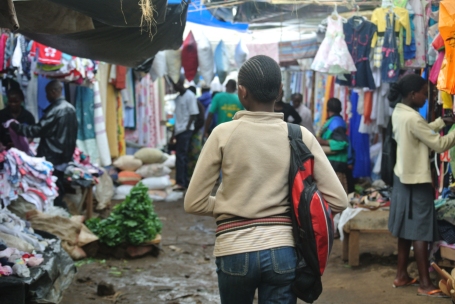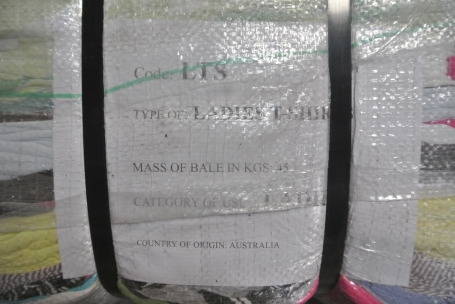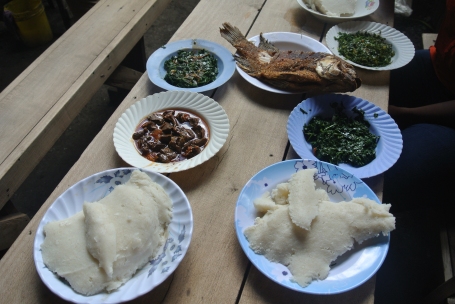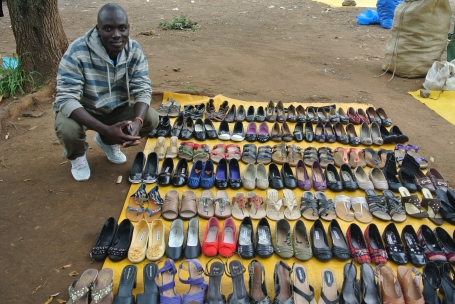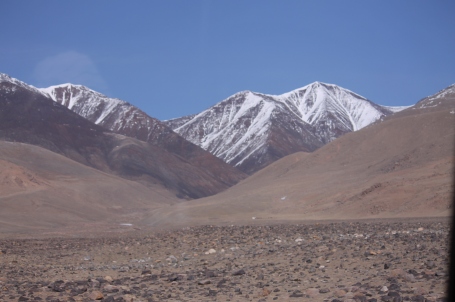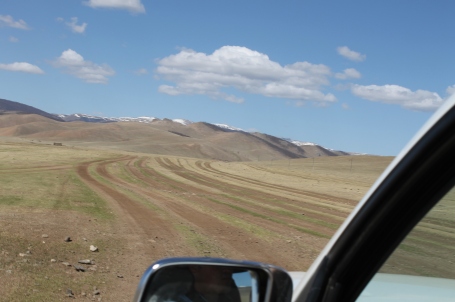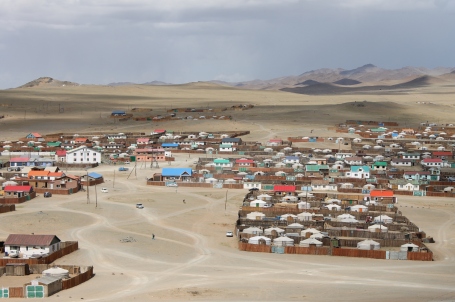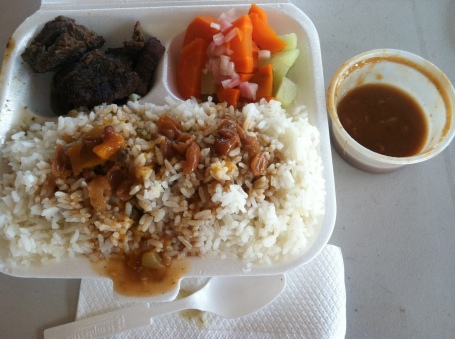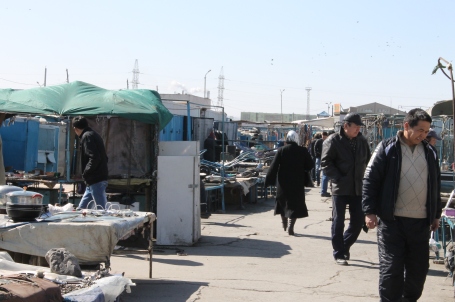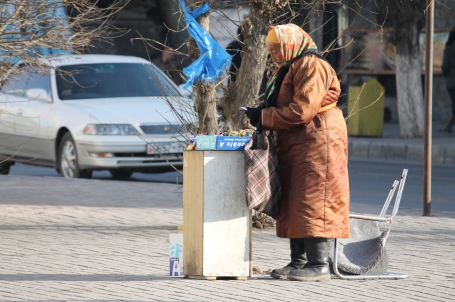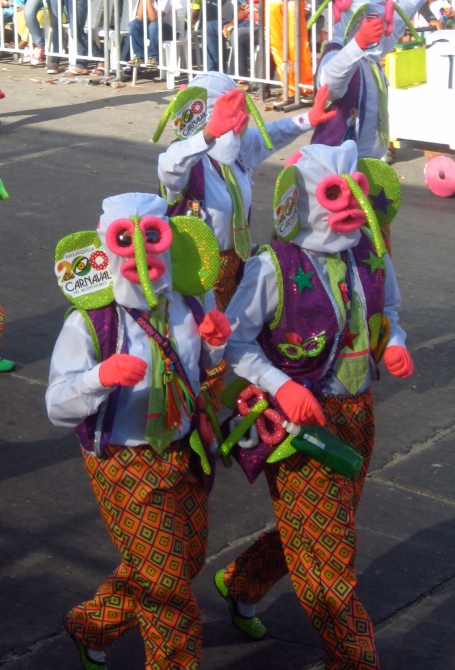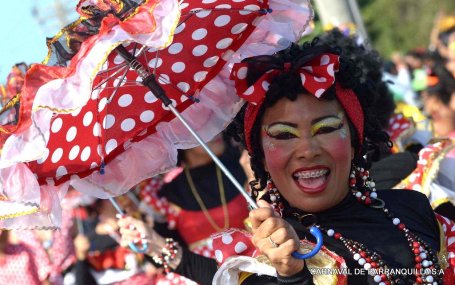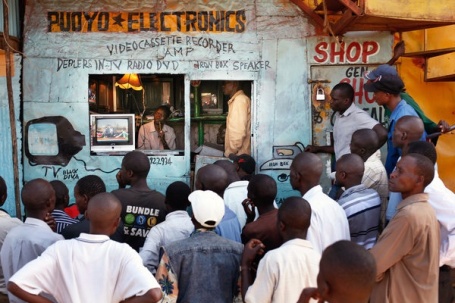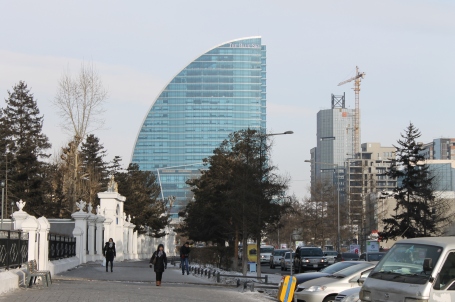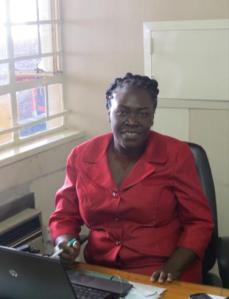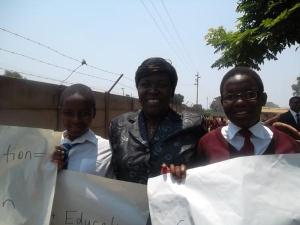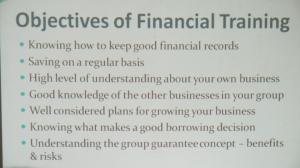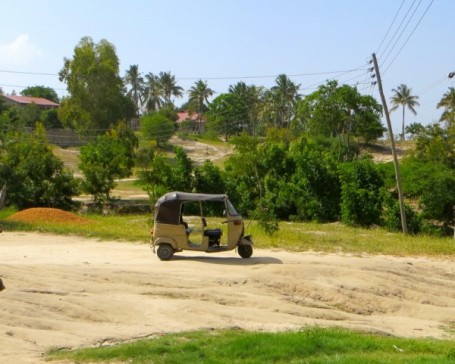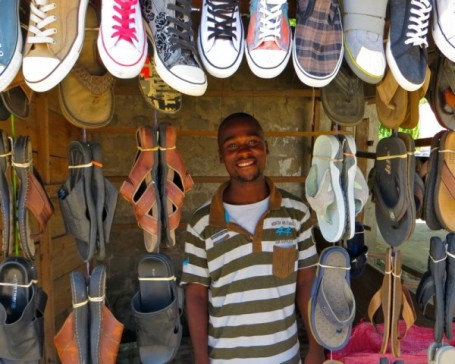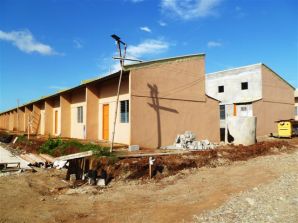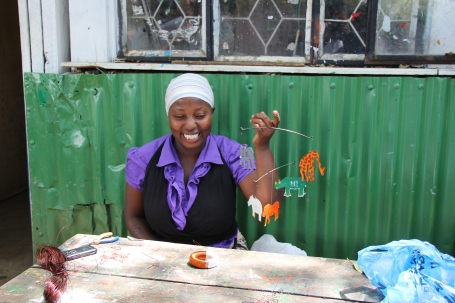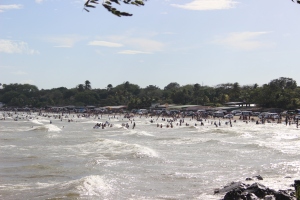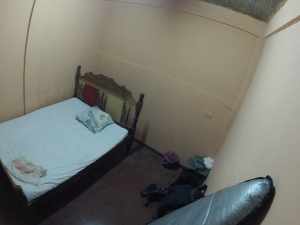Mitumba 101: The Second Hand Clothing Trade in Kenya
The Blue Sweater
The founder of non-profit venture capital fund, Jacqueline Novogratz, is the author of “The Blue Sweater: Bridging the Gap Between Rich and Poor in an Interconnected World.” In the book, she describes a blue sweater, donning “zebras in the foreground and Mt. Kilimanjaro right across the chest,” that she wore often as a child. Like many of our own childhood artifacts, the sweater was donated to good will once she started high school.
That exact moment is where the story goes global…
“Fast forward 10 years, about 5000 miles. I had left my career on Wall Street and was working in Kigali, Rwanda with a small group of women to start the countries first micro-finance bank to make small loans to poor women. When I was jogging through the streets, and low and behold 10 yards in front of me I see a little boy, pip squeak, knobby knees, wearing my sweater. So, I run up to the child, grab him by the color, turn it over and there is my name,” said Novogratz.
Novagratz’s sweater is one article of clothing among millions that are circulating the globe as part of the second hand clothing trade (SHCT). Although the SHCT accounts for approximately 0.5% of global trade in clothing, more than 30% of those imports went to Sub-Saharan Africa (SSA) as early as 2005. Figures provided by an Oxfam report indicate that used garments, initially collected and sold by western charities, account for nearly 50% of the clothing sector in SSA.
The SHCT is a billion dollar industry that spans the globe. According to a CNN report, “whilst exact continent-wide figures are hard to come by, global used clothing exports from OECD countries stood at $1.9 billion in 2009, according to 2011 U.N. Comtrade data.” An estimate in the same article approximates import activity to be worth $3 billion, and the subsequent retail transactions to be worth two-times that amount.
Mitumba 101
In Kenya the second hand clothing trade is known as mitumba.
Used clothing was first imported as duty free charity in response to regional conflicts during the 70s and 80s. The trade evolved into a commercialized business sector in the early 90s, when market liberalization policies were introduced into the Kenyan economy. Those policies allowed for the importation of goods, like mass shipments of used clothing, at reduced costs.
Indigenous textile industries across many African economies could not compete with the lower cost and higher quality of used clothing from abroad. In Kenya specifically, the resulting competition coupled with other factors like the collapse of the Kenyan cotton board, a drought from 1995-1997, lack of locally produced synthetic material and newly arriving cheap Asian imports, led to the closing of Kisumu Cotton Mills, Allied Industries Limited and Heritage Woolen Mills.
However, before you mourn the loss of local textile production, you should know that this is not entirely a sob story. From the ashes of one industry, another one has emerged quite triumphantly. Mitumba is a bustling business sector in Kenya. It has created thousands of jobs where the government and private sector have failed to do so. Furthermore, the state cashes in on import revenues and so do local city-municipal councils that require all vendors to purchase trading licenses regularly.
Mitumba is popular across the entire spectrum of Kenyan society. The poor could not afford to clothe themselves otherwise, while middle class and affluent Kenyans turn to Mitumba for designer labels and high quality, unique clothing intended for western markets.
- Western Charities: First, western charities sort through donations to add to their local thrift stock. Next, they sell the surplus to SHC dealers in order to generate funds for their programs and operations. About 80% of donated clothing is usually sold to merchants.
- Exporters/Importer: The second hand clothing merchants sort the clothing by condition and category; good/poor quality, women’s/men’s/children’s, shirts/pants, etc. Then, they’re bundled in plastic packaging called bales and shipped to the major East African port city of Mombasa in large containers. The bales are purchased by the ton. When they arrive in Kenya, they are stored in warehouses, mostly around the port of entry.
- Wholesalers: Major wholesalers purchase bales in Mombasa and transport them by truck to Gikomba market in Nairobi, ground zero for the wholesale mitumba trade in Kenya. Next, medium wholesalers purchase the bales and sell the clothing to retail vendors who travel to Gikomba from all over the country to purchase stock for their businesses.
- Retailers: Toi market, an offshoot of Kibera slums, is the largest retail market for used items in Nairobi. Other vendors fan out to cities and towns across the country.
On the Ground in Gikomba Market
Hop on matatu #7 behind the National Archives in town for the short ride to Gikomba Market, Kenya’s hub for wholesale SHC sales. This is a thrift shop on steroids. Gikomba is a labyrinth of rickety wooden stalls, adorned with rows of garments hung like ornaments on a Christmas tree. Vendors, perched above colorful mounds of clothing, call out to customers, shouting prices from their stalls. Bales of clothing are hauled through its narrow, muddy corridors on sturdy backs and rickshaws, as customers bob and weave through the chaos looking for quality clothing at the lowest price.
The sound of “camera, camera” fills the air. Clothing, both retail and wholesale, are sold in rounds by grade. Each round is called a camera, first camera, second camera and finally, the third. Once the bales are opened and sorted, the best quality clothes will be the first to go. Vendors often build relationships with each other in order to get first dibs on “first camera” clothing.
Francis, from the Kingara section of Nairobi, supervises a store that sells bales of clothing in the market. Drivers for the business go back and forth to Mombasa at least twice a week, bringing back about 70 bales of clothing with them each time. The drive from Nairobi to Mombasa is about 8 hours one way. According to Francis, a bale of 1st grade clothing can range anywhere from KHS 9000 (about $100) to KHS 14000 (about $200).

Francis is seated on a bale to the left. He supervises this wholesale bale business in Gikomba market. (Photo Credit: Katrina Shakarian)
Thomas Wahome, 24, and Samuel Mwangi, 28, have both worked in Gikomba market for 3 years. They rent a stall for KHS 1500 (about $20) a month to sell men’s and women’s jeans. At their stall, the cheapest pair costs 100 shillings (about $1.50).
Paula Bosire, an accounting student at Strathmore University, likes to mix and match her wardrobe. Some of her clothes are brand new from local chain stores and others are second hand. She is a frequent visitor to Gikomba, where she goes to find prices even cheaper than Toi’s. “I shop at Woolworth’s and Mr. Price for statement pieces and come to Gikomba for really good deals and things that are practically new. Sometimes the difference isn’t much,” she said. On this day, Paula left Gikomba with stylish scarves and a pair of slacks and jeans that cost KHS 40 (about $0.50) each.
Geoffrey Messo, 24, is a mitumba retailer at Umoja, an estate in Nairobi. He has been in business for 8 months and visits Gikomba twice a week to purchase new stock. He retains customers by building relationships with them, getting to know their styles and taking personal requests for items. According to Geoffrey, starting off as a mitumba retailer is not difficult because it requires very little capital upfront. However, like any business mitumba is not devoid of challenges. Sometimes Geoffrey is stuck with clothing that doesn’t sell.
Gikomba market generates tons of spinoff employment. It’s like a city within a city. Security guards are hired to protect stalls and stock. There are tailors on site to repair clothing and stalls set up exclusively for ironing. Shoe cleaners wait at the exit of the market with brushes, soap and water to wash off the mud accumulated from a busy day of shopping, and food vendors are on site to fuel the spending.
Naima, is known as ‘mathe’ in the market which means mother in shang, Kenyan slang. Originally from the coast province, she is the owner of ‘Real Madrid’ restaurant, located at the center of Gikomba’s hustle and bustle. She’s run her business in the market for 8 years. In addition to feeding hungry shoppers with typical Kenyan dishes like chapati, samosas and greengrams (lentils), she caters for parties and offices in the Westlands and Hurlingham sections of Nairobi. “People come from very far to pick clothes for their businesses. This is a meeting place for them. They sell, exchange, I let them do whatever they want [here]. They come in the morning, leave their things, I keep them safe while they go to buy. Then, they come to eat, talk with friends and return home, ”said Naima.

Naima’s business is more than just a restaurant. It’s a social gathering space for those buying and selling in the market. On a typical day, her establishment is filled with the sound of laughter and friendly banter. (Photo Credit: Katrina Shakarian)

Since there is no running water, Naima provides plastic gloves for finger food. (Photo Credit: Katrina Shakarian)
A portrait of Gikomba market would not be complete without mentioning that it is also Nairobi’s wholesale fish market. Hotels, restaurants, businesses and even individual shoppers flock here to purchase fresh and smoked fish from Lakes Victoria and Turkana.

Helen is standing to the far left, in front of her fish vending business in Gikomba market. (Photo Credit: Katrina Shakarian)
Geoffrey Messo, the clothing vendor who I met shopping for stock, introduced me to his mother Helen. She has been selling fish in Gikomba for 10 years. She sells fresh fish from Lake Victoria. She receives shipments of fish everyday. Along with most vendors in the market, she rents a space in communal refrigerators to store her supply. Her customers, many of whom are restaurant owners, come straight to her in Gikomba. She also makes home deliveries.
If you’re not in the mood for samosas or greengrams at Naima’s ‘Real Madrid,’ stop by the fish section of the market for freshly fried Nile perch, a side of sukuma wiki, kale, and the Kenyan staple ugali, corn flower cooked with water to a dough-like consistency.
On the Ground in Toi Market
Toi market is located at the outskirts of Kibera slums in Nairobi. According to Citizen TV Kenya, ”the market, which started in 1992 as a food center, where people could stop for a bite to eat, has become a vast emporium of second hand shoes, shirts, bags, pants and dresses. “ Toi market is the primary retail-shopping destination for the average Nairobean. It’s less hectic, more spacious and secure than Gikomba market, which is located near the city center.
Boniface started working in Toi in 2005. He has lived in the adjacent Kibera slums for 22 years. He was previously employed in the ‘jua kali’ sector making furniture, but left to go into business for himself. “ I wanted to be self-employed, to rely on myself and my own business, to live my own life, personally. The business is cheap to start,” said Boniface. Unlike most vendors in Toi who rent, Boniface owns his stall. He purchased it for KHS 25,000 (about $300).
Jackline Arunga, 18, is a newbie in Toi. She has only worked in the market for 1 year, selling children’s clothes exclusively. She rents her stall along the roadside for KHS 1500 ($20) a month. Once a month, she travels to Gikomba market to restock her supply of mitumba. Jackline’s long term goal is saving money to enroll in university.
Brisbane John Ndavi owns a stall in Toi market with his wife. They have worked here for a decade. Like for many Kenyans, it is difficult to survive on one income alone. So, Brisbane has more than one job. He is a full time security guard at an international embassy in Nairobi. Brisbane and his wife sell mitumba from a great location on the roadside. The price of owning or renting along paths, well worn from foot traffic, is double that of stalls off the roadside, deeper inside the market. Brisbane sited land ownership discrepancies as one challenge to feeling secure in this line of work. Neighboring Kibera and Toi market are both informal settlements, and who exactly owns the land has been a huge point of contention for decades. There are constantly rumors about developers seeking to gain ownership and wipe out the market. According to Brisbane, many vendors work with the fear that one-day, they’ll show up to work and find their structures ransacked and torn down.
Toi market is not just a hub for clothing. It is a central location for all kinds of used items. On any given day, it’s common to see customers, both affluent and poor, Kenyan and expatriate, combing through books, toys, electronics, utensils, accessories, furniture and other items. According to The Standard, Verah Aboga is one of the businesspersons who sells second-hand kitchenware. Aboga, who operates from Kitengela on the outskirts of Nairobi, sells the items on order to her customers in the city. Aboga noted that second-hand utensils are becoming popular because the market has been infiltrated by low-quality items. “Most of the sufurias (cooking pots) sold in the Kenyan market are very light and are not even made of stainless steel. This is what is making people switch to second-hand utensils, especially those who mind about quality,” she said.
Challenges to Mitumba
Market liberalization, coupled with the low purchasing power of the vast majority of Kenyans, has made the country fertile ground for the SHCT. It’s wildly popular across the entire societal spectrum. Nonetheless, there are several factors that could threaten the industry’s future in Kenya.
1) Cheap textiles from Asia are flooding the market. Although the competition from this onslaught is real, many Kenyans remain loyal to mitumba for its higher quality.
2) In 2012, the government raised import duties on SHC shipments. According to an article originally published in the Daily Nation, “While a container of mitumba used to attract duty of between Sh900,000 and Sh1.1 million before the new taxes were implemented early this year, the new rate is now Sh1.8 million, an increase of more than Sh800,000, they said.”
3) Local textile firms, that hope to stage a comeback, are lobbying the government to impose a levy on SHC shipments. They’d like the additional revenue to go towards a fund subsidizing cotton cultivation.
Although government policies and the ever-shifting tide of international trade may ultimately have it in for mitumba, the view from the ground doesn’t hint at a demise any time soon. At an average of 90% off western retail prices, how can you go wrong? Shop on Kenya!
The Women of MCDT
By: Abhishesh Adhikari
One of the Kiva partner MFIs that I am helping in Uganda is Micro Credit for Development and Transformation (MCDT.) It is based in Kampala and provides financial services primarily to low-income women who come to Kampala from remote areas of Uganda. Even though the average loan size for a borrower at MCDT is only about $200, it is amazing how impactful the loans have been in helping these women become financially independent.
Introducing FUNDAPEC: Supporting Higher Education in the Dominican Republic
by Rose Larsen | KF20 | Dominican Republic
The Dominican Republic may be a small island nation in the Caribbean, but it has a quickly growing economy based on a shift from exports of sugar, coffee and tobacco to services like telecommunications and tourism.

However, according to a study done by the OECD in 2012, this economic growth has been limited by deficits in human capital – more specifically, the education levels of workers are insufficient.
This problem stems from the low quality of primary and secondary educations – public schools are overcrowded, dangerous, and lacking supplies. Even students from lower-middle-class and poor families are attending private schools, which in the Dominican Republic can range from less than $50 a month to incredibly expensive.
By the time students manage to graduate high school, many families cannot afford to pay university fees, forcing the young people directly into whatever work they can find, often in the informal sector. If the Dominican Republic wants to continue to grow and bring a significant percentage of its population out of poverty, it needs to employ more workers in the formal sector – and to qualify for these formal sector jobs, workers need university or technical degrees.
On the more individual scale, it has been proven over and over that getting a tertiary degree increases lifetime earnings. If the Dominican Republic cannot find a way to help students from poor backgrounds obtain higher education degrees and have access to private universities, inequality (already a huge problem here in the DR) will only increase, and the economy will stagnate due to the lack of human capital.
ENTER KIVA AND FUNDAPEC
Kiva has been supporting entrepreneurs in the Dominican Republic since 2007 with Esperanza International, extending its reach in 2012 with a new partnership with ASPIRE. Up until now, all the loans Kiva has disbursed in the DR have gone towards small (often informal) businesses or personal expenses – stocking a corner store, buying supplies for a beauty salon, constructing a house.

FUNDAPEC’s offices in Santo Domingo
Meanwhile, Kiva’s newest partner, FUNDAPEC, has been giving out student loans for 46 years, and is the Dominican Republic’s only student loan provider. In the past FUNDAPEC has maintained strict minimum salary requirements for loan guarantors – usually the parents of the students. These requirements are meant to make sure that students’ families will be able to repay the loan, and are important in maintaining FUNDAPEC’s long-term sustainability, but they also mean that many poor students are turned away and simply cannot continue their studies.
FUNDAPEC has long wanted to provide loans to students from poor backgrounds, and through Kiva has finally found a way.
FUNDAPEC’S NEW LOANS
With the help of Kiva, FUNDAPEC has developed a new loan product specially designed for students with limited resources.
The loans can be used for undergraduate studies or for a technical (2-year) degree. Instead of having a minimum salary requirement for their guarantors, these loans actually have a MAXIMUM salary requirement – the guarantors of the students can have incomes no higher than 3 minimum monthly salaries ($480 USD per month or $5,760 USD per year).
These loans have some of the lowest interest rates on Kiva – 8% per year – and the terms are very generous. Students don’t have to make capital repayments on their loans until after they finish studying, and even then have up to 7 years to pay back their loans, keeping the monthly quota payments low enough that a recent graduate in his or her first job can keep up.
FUNDAPEC’S FIRST LOAN
When I arrived at FUNDAPEC’s offices to start getting the first Kiva loans going, the management team already had someone in mind to be the first borrower. They had received a letter from a girl who had no idea about Kiva’s program, but in desperation had sent a letter asking for help in finishing her education.
Crisley is only 20 years old, but has already been through a lot. An excerpt from her letter reads:
“3 years ago, studying was a distant dream due to a circumstance which changed my life and that of my family. I was diagnosed in 2009 with a chronic health condition. After multiple admissions to the hospital and after spending 6 months hospitalized on-and-off, I went into surgery.”
Crisley, instead of being defeated by her illness, has used it to inspire her. She is currently finishing her first year of studies in medicine, participates in a dance group, volunteers with the Red Cross, and hopes to one day be a doctor herself, so that she can help other people with similar conditions.
Unfortunately, in the Dominican Republic, years of hospitalizations and surgeries can bring even a middle-class family to the brink of poverty. Crisley’s parents have invested so much in her health that they can no longer afford to pay her fees at INTEC, the school she has been enrolled at. She still has special needs due to her condition, and continues to need some medical care and supplies, so the fees are still coming. Desperate to continue her education, she wrote a letter to FUNDAPEC hoping that somehow, even though her parents are now too poor to qualify as guarantors for FUNDAPEC’s normal loans, they would be able to offer her something.
Her letter came just at the right time, and we have just posted her profile on Kiva as the first Kiva borrower from FUNDAPEC, and the first borrower on Kiva to seek a higher education loan in the Dominican Republic. She is hoping to raise $9,700 which will pay for the next four years of study she has left on her medical degree.
Crisley embodies the hope and strength that Kiva looks for in its borrowers. She wrote in her letter to FUNDAPEC,
“I truly believe that everything in life happens for a reason, and maybe all of this was just the push I needed to know that my place is where I can serve, help and turn my experience into something positive in the life of someone else.
“Finishing my degree successfully is the dream I most want to fulfill, and with the help of God and while there is still life in my body I will continue fighting until I see it reached.”
Though Crisley is ready to fight, I think she’s already had enough struggles. With Kiva’s help, Crisley will not have to worry about her university expenses, and will be able to pay back the loan slowly once she finishes her studies.
FUNDAPEC’s loans are not for everyone. Lenders will not begin to see repayments for many years – in Crisley’s case, for five years – and won’t get the full amount of their loan back for up to 12 years. However, I can guarantee that these loans will change someone’s life. Lend through FUNDAPEC and support a young person who simply wants to get an education.
After serving as a Kiva Fellow in the 19th class in Barranquilla, Colombia, Rose Larsen is continuing her tour of the Caribbean with a placement in the Dominican Republic, as part of the 20th class of Kiva Fellows. She has been working with ASPIRE and FUNDAPEC. Click here to lend to a Dominican borrower today. To find out more about the Kiva Fellows Program and to apply to be a Fellow, visit www.kiva.org/fellows.
Kiva Fellows: Mixing Business with Pleasure
Here in Mongolia, my top priority with XacBank has been to complete borrower verifications (BVs)—visits to 10 randomly selected Kiva clients to ensure that everything in the field checks out with the information reported to Kiva’s San Francisco headquarters. As it happened, the borrowers in my sample were scattered across the country. Here’s a summary of what my month of April looked like:
- 1 month spent
- 4,872 km covered
- 9 borrowers verified
- 5 aimags traveled to
- 7 branch offices visited
- 10 training sessions delivered
- 35 loan officers and other staff trained
- 13 top Kiva borrowers recognized
- 1 television interview completed
- 67 client waivers checked
- 2 runaway borrowers chased down
- 1 Kiva Coordinator-Extraordinaire
- 2 beautiful lakes and other sights experienced
- 4 items delivered via Mongolian messenger service
- Many kilos of cheese curds (and other nice gifts!) received
I couldn’t help but feel lucky—I knew it would be an eye-opening experience to visit all these different parts of Mongolia. After all, I think most Kiva Fellows are in this as much for the professional experience as for the exposure to new countries and cultures. Why not mix business with pleasure if you can?
Runaway borrowers
I’ve talked before about some of the work that Kiva Fellows do when we visit branch offices during our BVs, but what I didn’t explain was how, in order to successfully complete a BV, the Fellow must meet with every single borrower on the list. If for whatever reason, a borrower is unavaible or nowhere to be found (and that’s happened before!), the sample must be re-drawn and 10 new borrowers must be verified—no matter how close you were to finishing the first set of 10 (and irrespective of how far and long you had to travel to see them). So it’s safe to say that Kiva Fellows sweat it a little when these meetings don’t line up perfectly. And people are often on the move, which can raise some serious logistical challenges sometimes.
Take Aibek, for instance. Batzul, the Kiva Coordinator at XacBank, booked us flights to go see him in Bayan-Olgiy, the western-most province of Mongolia (flying made sense given that Olgiy, the city centre, is a 3 day drive from UB). She also arranged our accommodations and made plans with the Director to deliver training sessions at the branch office. We were all set to leave on Monday morning, but late in the afternoon of the Friday before, she called me up sounding very serious: ‘Aibek is not in Bayan-Olgiy. He’s in UB right now. I just spoke to the loan officer.’
The trickiest part was that he was only planning to be in UB for a few days—which meant that by the time we came back from our branch visits in Bayan-Olgiy and Uvs provinces, he would have left already. We couldn’t change our flights, and flying to Bayan-Olgiy a second time was pretty much out of the question. So the best thing to do was to meet in UB during the weekend. We made plans to meet him on Saturday at 10 a.m. in his neighbourhood. We made our way to the east end of the city and waited… No Aibek.
Batzul called the loan officer in Bayan-Olgiy, who then called Aibek, but he wasn’t picking up his phone. We communicated through his wife, who was at home. We waited and waited. No Aibek. We gave up and agreed to try and reschedule.
Our opportunity came that afternoon. Aibek, the loan officer told us, would meet us by the Wrestling Palace at 1 p.m. When we got there we searched in vain for any passers-by who looked like the man in the borrower profile. An hour passed. No Aibek.
But the third time’s a charm, right? On Sunday afternoon I got a call from Batzul—Aibek had been located! We hopped in a taxi and made our way to the west end of the city. We were driven to a desolate, industrial area surrounded by auto body shops, where random vans were parked and people seemed to be waiting around for something. We waited in the safety of the taxi, but when no Aibek appeared, we cautiously stepped out and started asking strangers if they knew of our man. Eventually, one of them pointed us to a van, and lo and behold, Aibek was there!
Bayan-Olgiy
Our first stop in our travels was Bayan-Olgiy. Bayan-Olgiy is a special part of Mongolia: This region is home to the country’s Kazakh minority, giving it a very distinct feel from the moment you arrive. The Kazakhs, who make up some 90% of the population of this province, adhere to Islam (rather than Buddhism, like much of the rest of Mongolia), and the predominant language is Kazakh, not Mongolian (though most people speak both). From my hotel window, I could hear the evening call to prayers.
The Kazakhs were first drawn to the high mountain pastures in the region in the mid-1800s, where they let their sheep graze during the summer months. Throughout most of the 20th century, they were an isolated, tight-knit community, and this region is considered even by people in Kazakhstan as the best-preserved example of Kazakh culture. One of the things it’s best known for is the Eagle Festival, which takes place every year in October.
I think my Kazakh colleagues were as curious about me as I was about them. I immediately started learning some words in their language. Instead of bayarlalaa for ‘thank you,’ they say rahmed. Amansasbaa is the common greeting, whereas in Mongolian it’s sain bain uu (or more casually, you can say salem in Kazakh). And learning to say tansganmaa huanshtaman (it’s nice to meet you) came in pretty handy several times later on!
Having finished our work at the branch quickly, our colleagues took us to see the main mosque in town, followed by a hike up a nearby peak to get a beautiful view of Olgiy, the Altai Mountains, and the river that flows from them. Later, the Branch Director and driver took us on a long and bumpy drive to Tolbo Nuur, a freshwater lake about 50km south of the city centre. Though it was still frozen, it was amazing to see a body of water (there aren’t many in Mongolia!).
Next stop: A visit to the Branch Director’s extended family living in the countryside! True to Kazakh/Mongolian hospitality, they welcomed us warmly and prepared a massive and delicious feast for us. It’s customary for people in Mongolia to welcome strangers—locals and foreigners alike—into their homes and feed them. It stems from their nomadic history, in which families would help other people who were passing through the area, or receive visitors from different parts of the country (for example, the capital) and exchange news with them. It’s a beautiful aspect of the culture here.

the feast that they prepared for us (above) and our driver carving up 4 different types of meat (below)
On our way back to Olgiy, we soaked in the peaceful landscapes of the countryside…
A picnic at Uvs Nuur
By midweek, we were bidding farewell to our new friends in Bayan-Olgiy and boarding another plane, this time bound for Uvs. We were welcomed at the airport by a small crew, and no sooner did we arrive at the branch than we got down to business. Client waivers, visits to borrowers, loan officer training—check, check, check! Then the branch staff treated us to a warm welcome dinner at a nearby Korean restaurant. We were starting to feel like royalty!
The following morning, we had certificates and tokens of appreciation to hand out to 5 Kiva borrowers who had repaid their loans on time (or early). It turned out that the Branch Director had invited the local television crew to film the small ceremony! They asked me to say a few words about Kiva, so I was happy to talk about the good work Kiva and XacBank are doing. It aired on the evening news that night. I guess that makes me famous in Mongolia!
Next on the agenda was a trip to Uvs Nuur, a saltwater lake that is the largest in Mongolia. Lucky us! We followed a road for part of the trek but veered off after a while to avoid muddy areas where our SUV could get stuck. We zigzagged across an open field and eventually made it to the water’s edge, where Mongolians love to come and take a dip in the summertime. It was a cool but sunny afternoon, and we took in the warm rays as we sat idly by the water’s edge and enjoyed the picnic our colleagues had packed for us. We couldn’t have spent a nicer time in Uvs!
Business owners, an ancient monument and a stolen dinosaur
The following week, we hit the road for two more aimags, Arkhangai and Bayanhongor.
There, we had the opportunity to meet some borrowers who told us about their businesses. It’s always rewarding to make the connection between the borrower profiles on Kiva’s website and the people who are actually behind them. It’s also nice to see microcredit working effectively. These lovely ladies passed along their thank you’s to their Kiva lenders… Allow me to introduce them.

Byambahuu is standing in front of her produce and variety stand at the local market in Tsetserleg. She was recognized by XacBank for her efforts to repay her loan on time, getting back 9% of the amount she paid in interest deposited back into a savings account.

Oyunchimeg has a dairy stand at the local market in Tsetserleg, where she sells cheese curds and other milk products. She makes some of these products herself, while the rest she purchases from nomadic herders in the countryside.

Munhdelger sells a variety of housewares and other useful household goods at the outdoor section of the local market in Tsetserleg.

Gerelmandah is a tailor in Bayanhongor who takes custom orders to make beautiful traditional Mongolian clothing, such as deels (below). It’s a trade that was passed on to her by her mother, and one which she is now passing on to her own daughter.
While visiting these aimags, we also learned about some of Mongolia’s rich natural history. Not far from Tsetserleg, Arkhangai’s city centre, is Taikhar Chuluu, a large rock formation that juts out in the middle of a wide plain. Legend has it that a snake emerged from the earth one day, many moons ago, and a hero named Bökebilig forced it back and sealed off its cave with this rock. The rock has been revered by various civilizations since ancient times, as evidenced by the Mongolian, Tibetan, and Turkic inscriptions which can be found on it (the latter which dates back to the 6th century AD, although sadly, most of the inscriptions have been overwritten by modern-day graffiti).
And did you know that it’s possible to smuggle a dinosaur out of a country? Luckily, the one that was taken from Mongolia is now on its way home. Bayanhongor, which is part of the Gobi Desert region, is home to some of the incredible dinosaur fossils that have been unearthed since the 1920s. These include many dinosaur eggs and several Velociraptors (which of course you’ll remember from Jurassic Park!). One of the most famous discoveries is of a Velociraptor and a Protoceratops that were locked in battle and frozen in time 80 million years ago. You can also see exhibits such as a nest of newborn baby dinosaurs, and a mother protecting her young at the Natural History Museum in UB—that is, when they’re not out touring the world!
The Mongolian Messenger
I witnessed another curiosity during these BV travels. In a country where there are effectively no street names or real addresses, I’ve been intrigued by how mail gets delivered around here. You may know that the Mongolian Empire had a highly developed mail system at the height of its rule. People have assured me that when they receive mail—that is, anything that cannot be taped to their doors—they are given notices to go pick it up at the nearest postal outlet. Sounds reasonable, right?
But the truth is, Mongolians today have instituted an informal delivery system that would surely do Chinggis Khan proud. My edification began as Batzul and I waited in line at the check-in counter in the UB airport to fly to Bayan-Olgiy. A man was hovering nearby, and finally he approached Batzul. They exchanged a few words in Mongolian; he passed her an envelope, and she took down a phone number. I observed the whole interaction somewhat suspiciously.
‘What was that all about?’ I asked after the man had gone.
‘Oh, he just wants me to deliver something in Olgiy,’ she replied casually. And to my confused stare, she added, ‘It’s the Mongolian Messenger service.’
As if that explained everything! My jaw must have dropped. I started sputtering… What? How? Who?? I was full of questions!
These questions were somewhat cleared up when we arrived in Olgiy. As we stopped for lunch with our branch colleague, Batzul got on the phone and a short while later, a lady walked into the restaurant. Just a few words were exchanged before the envelope was handed over and the lady walked back out. I watched in fascination. ‘How did you know she was the right lady?’ I exclaimed.
‘Because I just talked to her on the phone,’ Batzul answered matter-of-factly.
‘But don’t you need to see her ID or something?’ I persisted.
‘No.’ We resumed eating.
This happened again and again until I finally started to believe in the system. Coming back to UB this time, we walked out of the baggage-claim area of the airport and Batzul delivered another envelope straight into the outstretched hands of a stranger. She knew him by the black shirt he was wearing, she assured me. On the way into the city, our driver stopped along the road from the airport, not once but twice, at seemingly random intersections where our little Messenger hopped out, delivered her goods to waiting recipients, and hopped back into the car. I was blown away.

a typical plane which carries private messages across Mongolia… and an example of a messenger who delivers the service
The Kiva Coordinator-Extraordinaire
Speaking of this Messenger, delivering envelopes isn’t Batzul’s only talent. For the past four months, I’ve had the pleasure of working with her, and for good reason: She is a truly exemplary Kiva Coordinator. We’ve worked closely together, particularly during all of our branch visits for the BVs, and I must say we’ve made a great team. We get our work done quickly and efficiently, and even have time left to have some fun (as you now know).
But it’s not just that. Batzul is an impressive young professional all on her own. She is always on the ball with her Kiva work and manages several other projects on top of that. But the best part about her is that she takes immense pride in her job as a Kiva Coordinator, and also in the fact that her work is impacting the lives of many Mongolians. Whether we are running a training session together, or visiting a borrower, she’s been far more than just a translator. She elaborates by adding anecdotes and lessons from her own stock of experiences, including her interactions with branches, loan officers, and clients, thus adding colour and depth to the messages we deliver. She makes my job as a Kiva Fellow easy!
Just as I had thought, the opportunity to see so many different parts of Mongolia for my BVs was fun, rewarding, and incredibly enriching. And I have Batzul, the Kiva borrowers, XacBank, and all the incredible people at the branch offices we met to thank for that—so from the bottom of my heart, thank you everyone for a truly amazing experience!
What Green Means in Mongolia

a massive silver statue of Chinggis Khan looms 40m high on a snowy spring morning at Tsonjin Boldog, east of UB
Spring may have arrived in Mongolia, but for two Kiva staff who visited me in April, winter gave one last hurrah and dumped the largest snowfall I’ve seen since being here (a whopping 2 inches!).
If you’ve had a chance to read some of my past blog posts, you’ll already know that winter in Mongolia is a big deal—even for a Canuck like me. (more…)
Solar lamps in El Salvador. Loans that are making the difference
One popular critic to microfinance is it promotes businesses that don´t bring value. For instance, giving a loan to a woman to start a tomato shop beside 10 other tomato shops. Instead of creating value, it divides it.
This is why one of the biggest bets from Kiva are green loans. Under this category you can have solar lamps, ecological kitchen and other type of products that aim to improve families standard of life.
I was not sure of the effectiveness of this type of loans until I met….. He has a very humble family that lives in the coast of El Salvador and he is a fisherman. One day the loan officer told him about a solar lamp that could take energy from the sun and turn it into light and electricity. After serious discussions with his wife they decided to risk and buy it.
3 months after they bought the solar lamp and with his own words: “It is the best purchase we have ever made, it has changed our lives”.
Before they used candles, which apart from being expensive and dangerous, (they live in a wooden cottage), they did not bring light enough. With this solar lamp, children can now do their homework after the sunset and potential robbers are also espantados. One other curious thing that has changed is now his mother (grandma) wants to go and have dinner with ner grandchildren. Before she did not want to go because she said there was not enough light and you could not see. Now she goes whenever she can.
Moreover, they have found a way to get income from the lamp. As this lamp enables charging cell phones, they offer to their neighbors recharge their batteries at a fair price, bringing advance to their community and saving them time.
These last Christmas have been the first ones with proper light. And this big change hasn´t cost them at all, because the monthly expense in candles thay had is now their monthly fee to Integral and Kiva. After one year, their loan will be fully repaid.
Kiva. Loans that change lives.
A Kiva Zip Entrepreneur in Chicago
By: Abhishesh Adhikari
One of the best parts about my Kiva Fellowship has been the opportunity I get to meet and interact with entrepreneurs. During the 4 months that I spent in Kyrgyzstan, I helped Bai Tushum (Kiva’s partner MFI) launch a new Startup Loan Product and met a wide variety of entrepreneurs all across that country. After I got back from Kyrgyzstan in January, I have been working on a new Kiva project called Kiva Zip, trying to expand it here in Chicago.
Kiva Zip is a new initiative to make interest-free, small business loans to entrepreneurs in the United States. This new lending model is based on community relationships whereby entrepreneurs can request interest-free loans (up to $5000 for the first loan) based on endorsements from organizations or prominent individuals in their communities. Lenders can view the profiles of these entrepreneurs on Kiva Zip’s website, and lend $25 or more at a time.
Of Baby Animals and Borrowers in Selenge
Spring has arrived in Mongolia! That means warmer weather (afternoons creeping closer and closer to the double digits)… and, of course, baby animals!
I had the opportunity to travel to Selenge aimag (province) last week with XacBank, one of Kiva’s partners in Mongolia. (more…)
What I Learned from Borrower Visits: 4 Dominican Experiences
by Rose Larsen | KF20 | Dominican Republic
One of my first tasks upon arriving in the Dominican Republic was to visit 10 borrowers, chosen at random from all of the borrowers with ASPIRE (Kiva’s partner MFI), to verify data and find out how they are doing on their loan. This was an exciting but challenging introduction to daily Dominican life, as I navigated Santo Domingo and the surrounding areas via shared taxis, public buses, motorcycles, the metro and my own feet. I traversed bustling neighborhoods in the center of Santo Domingo, small towns in the mountainous interior of the country and everywhere in between, seeking out 10 lucky individuals to interview for Kiva’s audit of ASPIRE.
As a recent arrival in the country, it was a great experience to learn more about the Dominican Republic and what it’s really like to live here. Though each visit was uniquely interesting in its own right, four experiences stood out as having taught me a lot about what life is like for Kiva borrowers in the DR.
1. Dominicans have a very strong connection to the United States
I have often been surprised by the number of Dominicans who speak to me in near perfect English. Everyone seems to have a cousin or an uncle or a sibling in the States (mostly in New York and New Jersey), and many Dominicans that I’ve met have spent years living in the US as well. According to the census, in 2010 there were 1.5 million people of Dominican origin living in the US.
But what really drove that home to me was when I met my first Kiva borrower, Ramon, the owner of an internet center in the town of La Vega. He heard my accent when I spoke to him over the phone to arrange our meeting, and asked me where I was from. When I said the US, he told me he had lived there, all over – in New York, New Jersey, and Maryland.
As we began our interview in his little computer center, I was surprised to hear him answer my questions in perfect English! After months in Colombia of struggling to understand Kiva borrowers’ difficult Costeño Spanish accents (the ends of all words seem to be cut off), this interview was a breeze!
Like many other Dominicans, Ramón moved to the US in search of a better life, and spent 20 years there. Unfortunately his wife preferred the Dominican Republic and he had to move back. He said that here in the DR, it was much harder to make enough money to live on, because here, inflation is high but wages and income streams remain low.
2. Dominican food is delicious, and Kiva borrowers sure know how to cook
I arrived in Villa Altragracia in the early afternoon, and the branch manager immediately rushed me into the lunch room to eat the Dominican lunch they had ordered for me. It was a plate of rice, soupy beans that are called “habichuelas,” salad, and stewed beef – this is the national dish of the Dominican Republic and is called “La Bandera Dominicana,” or “the Dominican Flag.” The bandera dominicana comes in many variations – sometimes the beans are red and sometimes they are black; the meat can be beef, chicken or pork; and it is often accompanied as well by plantains. The meal I was served in Villa Altragracia was simple but really tasty.
After eating a satisfying lunch I followed a loan officer down the street to a Kiva borrower’s restaurant. It was only after finishing the interview and leaving that I found out that the ASPIRE branch office had ordered my lunch from there! I only wished I could have thanked her for the delicious meal.
3. Riding on the back of a motorcycle on a highway is terrifying, but loan officers do it daily
The second borrower I was scheduled to visit in Villa Altragracia was apparently not walking distance from the branch office. Since Villa Altragracia is a fairly small town, I agreed to get on the back of a loan officer’s motorcycle, so we set out motoring down the main road in search of Nailan.
I was very surprised when, 10 minutes later, I found myself merging onto Autopista Duarte, one of the main cross-country highways in the Dominican Republic. I clutched the waist of the extremely young-looking loan officer sitting in front of me who suddenly held my life in his hands. We stayed mostly on the shoulder, zooming by people selling snacks by the side of the road, and my heart leaped every time an enormous truck went by, going twice as fast as us.
20 minutes later I shakily stepped off of the motorcycle, and Nicolás, the loan officer, seemed surprised by how much the journey had scared me.
“I make this trip every day,” he said. “I used to have a car to do it, but the motorcycle is cheaper.” Gas prices are astronomical in the Dominican Republic – prices are currently at $5.25 per gallon! I had a renewed awe for the hard work that loan officers do to reach borrowers, even ones who are not very conveniently located.
4. Kiva Borrowers Span Many Economic Levels
My visits around the country were a great opportunity to see how normal Dominicans live – I visited their homes and businesses, met their families, and even shared meals with them. I was struck by how different each borrower’s life is – the pair of borrowers that I visited in the Santo Domingo neighborhood of Los Alcarrizos were the perfect example of these contrasts.
One borrower who left an impression on me was Papio. We found him spending the day at his parents’ home, a few kilometers down a dirt road outside of Los Alcarrizos, a working class neighborhood in Santo Domingo. He took out his loans to fund two of his businesses – a car and motorcycle repair shop, and a “colmado,” or corner store. He was spending the day overseeing construction on his parents’ land, where they raise chickens, bees and will soon rent out the new buildings they are currently working on. This was a man with multiple lucrative businesses – though perhaps the home was modest by US standards, he was clearly not struggling and in fact seemed to be flourishing, especially with the help of his Kiva loan! Though these borrowers are not what one normally thinks of when imagining a Kiva borrower, the money they borrow can go very far – Papio has multiple employees at his various businesses, all of whom depend on him doing well.

(clockwise from top) The new structures Papio was working on; Papio and his ASPIRE loan officer, Amarilis; the family’s chickens; a hired worker digging a well
I spent an hour exploring the extensive acreage owned by Papio’s parents, as he pointed out different types of trees and plants that they grow – besides bees and chickens, they also produced mangos and avocados. I even got to share a meal with them.
Another borrower lived nearby, in the same municipality as Papio. To get to Elisabel, we bumped along down a dirt road filled with potholes, passing rundown shacks that housed whole families. The only day Elisabel was available to meet was Saturday, as she works the rest of the week as a maid in someone’s home – she finished paying off her loan a few months ago and unfortunately is not currently running her own business anymore.
Her home was very basic – a small wooden construction with a tin roof, and a tiny yard out front where a few chickens scratched in the dirt. The difference between Papio’s parents’ acres of land and well-furnished home and Elisabel’s shack where she, her husband and their three children lived was huge – it was hard to believe they lived just a few miles from each other. The difference in the quality of their lives was even more obvious.
Elisabel and Papio, though different, can both be helped by microfinance and the loans that ASPIRE and Kiva provide – though at very different levels. Elisabel’s loan was for $5000 pesos while Papio took out a $40,000 peso loan. The Dominican Republic has a lot of poverty, but as you can imagine, this poverty doesn’t always look the same, and it’s important to remember that Kiva borrowers don’t fit just one profile – they are as diverse in background as Kiva lenders!
Rose Larsen served with the 19th class of Kiva Fellows in Colombia and is now serving her second fellowship with KF20 in the Dominican Republic, with Kiva partner ASPIRE. Lend to one of ASPIRE’s borrowers today, or apply to be a Kiva Fellow!
Young Kenyan Entrepreneurs at the Forefront of Tech Innovation
Young Kenyans are harnessing their country’s growing tech prowess to go into business for themselves. For example, Jamila Abbas and Susan Oguya, created a mobile application called M-Farm. The application allows Kenyan farmers to access real time market information, buy farm inputs from manufacturers and find buyers for their produce, all through SMS. Lorna Rutto started EcoPost, a company that turns plastic waste into durable fencing posts, an environmentally friendly alternative to timber. At Strathmore University, Kenya’s leading institution for business and accounting, many students are interested in pursuing traditional career tracks like joining the ranks of major financial firms, but quite a few are just as eager to start their own enterprises like Jamila, Susan and Lorna. On a recent afternoon on campus, I sat down with Asha Mweru to discuss Chochote, an e-commerce platform that she launched with her classmates Ivy Wairimu and Victor Karanja. Chochote, which is the Swahili word for “anything,” started as a simple classroom assignment.
The team of 4th year Strathmore students sought to connect buyers and sellers on a platform based on excellent customer service, discounted prices and home delivery. Currently, it targets consumers between the ages of 18 and 48. Chochote’s tagline is “not just anything.” It’s transitioning from offering a wide range of products like electronics, cosmetics and clothing to a narrower, more particular supply of unique crafts, jewelry and fashion items, similar to Etsy. Ivy explained that, “Kenyans are very specific [about] what they are buying. So, we [investigated and] found out what the specifics are,” then decided to re-brand.
The project has received support from the IDEA Foundation and ilab Africa’s business incubation center at Strathmore. Currently, they get between 600 and 900 hits a day and hope to reach the likes of popular Kenyan e-commerce sites like Uzanunua and Online Shopping. Their foreseeable goals include increasing their suppliers, expanding to reach consumers across the region and establishing a Chochote mobile application. After all, Kenyans are just beginning to warm up to the idea of online shopping. “Since everything is going virtual, why should Kenya only shop at Amazon? Why shouldn’t we have our own thing here? Kenyans between the age of 18 and 48 have accepted that the internet is here, it’s here and sure to be used. They’re accepting it, so let’s grow with them,” said Asha.
Nonetheless, online shopping is a very new concept here. “Kenyans are still quite skeptical towards e-commerce and this is a challenge we’ve had to take head-on,” said Asha. Other challenges faced by the team include accessing seed capital, establishing relationships with reliable suppliers and remaining abreast of clients’ changing preferences. On a macro level, the team points to the current state of Kenyan primary and secondary education as a hurdle to overcome too. In conversations with Kenyans, I’ve personally heard that there’s more of an emphasis on memorization than critical thinking. According to Victor, “Someone once said that our education system is meant to produce employees not employers. Notable, however, is the number of Kenyan entrepreneurs that circumvent these challenges therefore making it easier for the rest of us.”
Despite these challenges, the Chochote team would not have it any other way. “Honestly, I’ve never liked the idea of being micro-managed, and solving a problem and actually seeing the solution being implemented gives me a thrill,” said Victor. The team explained that the most exciting part of entrepreneurship is the ability to create employment opportunities rather than compete for limited slots that are already there. Ivy’s dream is not only to see Chochote become profitable, but to ensure that it expands enough to generates jobs. “Through our work with Chochote, [we’d like to] build a successful e-commerce model that can be replicated within Kenya and Africa at large.”
Perhaps, the team’s experience will have them avoiding 9-5’s forever. They’re part of a new generation of Africans who are inspired by the likes of Muhamed Yunus, public intellectual Dambisa Moyo and the founder and CEO of Open Quest Media, June Arunga, among others. Both women were chosen by Forbes Magazine to be among the 20 Youngest and Most Powerful Women in Africa. In addition to the rise of visible role models that they can relate to on the global stage, their immediate environment is more conducive to innovation than ever. In Kenya, sky’s the limit.
A Glimpse of Microfinance and Urban Poverty in Ulaanbaatar
Last week I started visiting some of Kiva’s borrowers with Transcapital, one of Kiva’s field partners that I’m working with here in Mongolia. While it was really encouraging to see Transcapital’s enthusiasm for Kiva at the head office as well as its various branch offices around Ulaanbaatar (UB), the new insights I’ve gained on urban poverty—both from these visits as well as just day-to-day life here—have left me perplexed so far, with far more questions than answers.
A short term solution?
Our visits began with a stop at Narantuul market, the largest outdoor market in UB where a number of Transcapital’s clients have retail outlets. At a first glance, Narantuul is a colourful and vibrant marketplace where vendors sell everything from food and candy, to winter coats, scarves, belts, jeans, baseball caps, cardboard, and more. It’s the place where Mongolians often go to find cheaper wares, which makes sense considering some of the staggering prices I’ve seen at Ikh Delguur, the State Department Store. We spoke to Bayasgalan, the proud owner of a shop selling winter coats and clothes, a long time client of Transcapital’s, and a Kiva borrower.
Other vendors watched us with curiosity as we chatted with her, and the mood at the market was lively despite the cold. But my translator friend, whose family had sold candy there, explained to me as we left that pretty much all the vendors there need continual loans to in order to sustain their businesses. Without loans, they can’t operate; but even with loans, they struggle to get ahead… which is anything but encouraging.
Harsh working conditions
The next day, we visited Kharkhorin market, UB’s second largest outdoor market, located on the other side of the city. The wares there were slightly different: I saw lots of shoes, but also an eclectic collection of hardware parts, sinks, ropes, tools, and other random second-hand items.
We had trouble locating one of the two borrowers we had to meet, so we wandered around for some time looking for her. In the meantime we met and chatted with Saranchimeg, who had used her loan to increase her supply of winter boots. We had been outside for about 45 minutes by the time we finished chatting with her, and I thought my fingers and toes might fall off. It must have been around -25oC that day with the sharp wind whipping through the stalls. But my thoughts were with the market’s vendors who stand out there all day long, day in and day out. My translator friend assured me that, just because they’ve lived in Mongolia their whole lives, it doesn’t make the cold is any easier for them to bear. I was humbled by how hard they work.
The reality for taxi drivers
We also visited with some taxi drivers. While a male taxi driver may not be one of the sexiest loans on Kiva’s website, you should know how hard these people work to support their families, just like anyone else. And for what? Being a taxi driver is a tough way to make a living in UB: A one-kilometre ride will earn a driver about 1,500 Tugriks (or 1.07 USD).
Moreover, the competition is stiff. Since cars have become ubiquitous in Mongolia’s capital, everyone has become a taxi driver. It’s an overhang from the early days of capitalism, when cars were not that common and the city’s residents would help each other out by giving rides. Now, you see people on the streets with their hand out all the time, and it usually only takes a few minutes for a car to pull over.
Another borrower we met lived in one of the outer ger districts, the slums of the city which lack basic services like running water and sanitation. He was middle-aged and had taken out a housing loan, but he told us that he had been a driver under the socialist regime. He explained that he had had much difficulty in finding employment in his profession. Recently, though, he has started applying for driver jobs again. It’s a mystery to me how he has managed to make ends meet over the years.
Survival of the fittest?
It’s easy to think that people don’t work because they’re too lazy, or because they simply refuse to accept lower-paying positions. This may be true in some cases. But there may also be more to the issue than meets the eye. Mongolia had its Revolution and transition to a market economy in the early 1990s and it seems the transition was difficult for those who were brought up and educated in the socialist era: Many of their skills and experiences have not translated well in the new economy. While a lot of the leadership I’ve seen in white collar jobs are shockingly young—in their late 20s or early 30s—street and market vendors tend to be in their 50s or older. And for many of them, their wares include no more than a couple handfuls of gum and candy, which can’t possibly bring in that much at the end of the day.
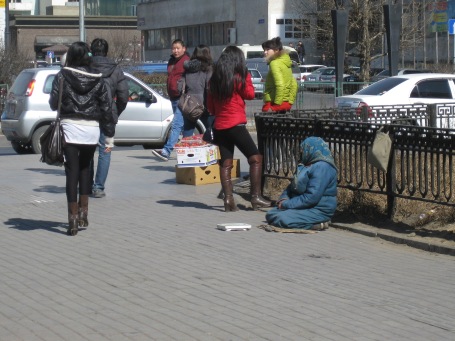
some people sell fruit, others sell services such as the use of a telephone or a scale (like this lady here)
Maybe skills training is needed to support these people… or maybe it’s not that simple. Imagine being in your 40s or 50s and getting trained (or competing for jobs) alongside people who are a whole generation younger than you. And the longer you stay out of the workforce, the less confidence you generally have to return to it. One colleague of mine surmised that perhaps self-employment is the way to go for these people.
The fork in the road
Of course, this reflects only one facet of urban poverty here. Another, and perhaps larger, driver is the massive migration of traditional nomadic herders to the capital, as zuuds—extremely harsh winters—have killed off the millions of animals on which they depend for their livelihoods.
Mongolia has gone through some incredible changes over the past several years, thanks to the discovery of the largest unexploited reserve of copper, gold and silver in the world. Roads have appeared where they previously didn’t exist; herders have disappeared from the streets of UB; shiny new buildings have gone up; inflation has gone through the roof. It’s poised to be one of the fastest growing economies in the world in 2013.
There is immense potential for large-scale economic development and poverty alleviation in Mongolia. Microfinance is helping to tie things over, but how the country handles big issues such as corruption will ultimately determine whether the spoils will be shared by many. So far, everything I’ve taken in only seems to have raised more questions. I’ve only scratched the surface in terms of grasping the complex economic factors at work in this country, much less understanding the solutions.
“Onipa Nua”. The importance of a group
This last week I have started to meet borrowers and feel the reality they face. It is a reality full of difficulties and challenges, in which a small amount of money can make the difference to the person that receives it, his family and his community.
ID Ghana has a different approach to microfinance, they call it “Onipa Nua”. It is based on group relationships. What they do is forming 15 to 40 people groups (95% of members are women) and they are trained in different abilities: saving, convive, how to manage a business, loaning, health…and many more areas that help them build a successful group up.
Once groups are formed and leaders are elected, (this can take several months), they are ready to start saving and borrowing money. This is how a “Onipa Nua”is born.
Each member of the “Onipa Nua” is only responsible for his loan, and does not guarantee other members´ loans. However, as in these countries “your problems are also your neighbors and friends´ problems”, the compromise borrowers have with their loan is total, and under any circumstance they want to let other members down.
Onipa Nua´s members are extremely aware of the importance of a loan and what it implies, this is why they just borrow what they need, and if it is necessary, they stop eating rather than stop paying back their weekly fee.
When you see this, it gives you goosebumps. You feel again those values that are not fashionable anymore, like compromise, effort and honesty.
This reminds you that what is worth in life is what you achieve following those principles.
The Various Forms of Currency of Zimbabwe
Zimbabwe made world headlines over the course of 2008 and 2009 when hyperinflation gripped the country. What is often believed to simply exist in economic textbooks was occurring daily in the streets; the government was printing more and more Zimbabwe dollars, the currency would lose its value, more Zim dollars needed to be printed, new bills had 1, 2 or even 3 zeros added to the end, the currency would further lose value, more printing…
These events led to peculiar sights such as “starving billionaires” as well as Zimbabweans needing a couple of suitcases full of bills in order to purchase a simple loaf of bread.
Locals even told me stories of million dollar bills lining the streets. No one would “waste their time” picking them up since at one point a million, or even 10 million, Zimbabwean dollars was absolutely worthless.
As much as such images can appear amusing, the daily reality was painful for the vast majority of Zimbabweans. Even if you managed to amass enough bills to purchase any basic goods, chances were that a grocery store’s shelves were empty since it was too expensive to import any products into Zimbabwe.
Officially transactions in foreign currencies were illegal, but unofficially everyone started operating in US dollars and South African Rand. Eventually the government abandoned the Zimbabwean dollar and officially adopted the US Dollar.
The switch in currencies hasn’t necessarily fixed all issues. Nowadays there simply are not enough small bills and coins in circulation. ATMs spit out crisp $100 USD bills but the only available $1 USD bills appear to date back a few decades earlier.
This lack of available change has led to daily issues as well. For instance I numerously had enough money to pay for groceries, lunch, coffee, taxi ride, etc. but I happened to have a $20 bill when the cost was less than $5 or $10. In such situations you can either skip the purchase, receive a credit receipt for the change you are owed or at times forced to forego the entire $20.
For smaller change, such as coins, South African Rand, and at times other African currencies, are commonly used in daily transactions. At various stores you can also receive candy in lieu of actual change. Unfortunately the candy is just like the $1 USD bills, it’s usually pretty worn out.
#KenyaDecides 2013: Election Coverage from the Field
On March 4th, 2013 over 12.3 million Kenyans headed to the polls to elect their next parliamentarians, senators, governors and their fourth president since independence 50 years ago. In the weeks prior to the big day, Kenyans urged one another to become registered voters, consequently breaking all of its election records to date. Over 14.3 million people registered to vote, 86.1% of which turned out on election day. Many voters woke up before dawn, queuing as early as 1:00 am, and waited more than 10 hours to cast their ballots.
The atmosphere leading up to the elections was one of caution and optimism. The 8 presidential candidates participated in two nationally televised policy debates, the first ever to take place in East Africa, during which they personally pledged to spearhead peaceful campaigns. All recent YouTube clips have been prefaced with advertisements of young athletes urging Kenyans to vote peacefully. The presidential candidates joined hands and posed for pictures that splashed across the front pages of newspapers, symbolizing their collective commitment to preventing a repeat of the post-election fallout in 2008. Last week, Kenyans across all ethnic lines joined together in a prayer vigil for the upcoming vote in Nairobi’s Uhuru Park.
Kenyans held their breathe and waited five days for the results. The delay was caused by the toll of high voter turnout on election infrastructure. The new electronic counting system crashed and a row broke out over whether spoiled ballots would be included in the official count or not. On Saturday, March 9th, the Independent Elections and Boundaries Commission (IEBC) finally announced that Uhuru Kenyata cleared the 50% threshold required by the new constitution and beat Raila Odinga by .07%. According to the New York Times, “The second-place finisher, Raila Odinga, Kenya’s prime minister, has refused to admit defeat and plans to appeal to Kenya’s Supreme Court to overturn the results.” There is also a tenuous cloud hanging over the winners, Uhuru Kenyatta and running mate William Ruto, who have been accused by the International Criminal Court (ICC) of crimes against humanity for their alleged role in stoking the violence during the last election. Consequently, many Western nations have issued statements that commend the “Kenyan people” for exercising their democratic right peacefully, but stop short of congratulating Uhuru Kenyatta and William Ruto.
Although Raila Odinga plans to contest the loss of his third presidential bid and there is some apprehension about Kenya’s standing within the international community, Kenyans have had their say. Nairobi is calm and people seem keen on accepting the results and moving on with their daily grind. The biggest winner in this election is peace. There is a deep seated commitment to maintaining law and order across the entire societal spectrum that began in 2010, when 67% of Kenyans approved a new constitution, in direct response to the policies or lack there of that framed the fallout in 2008. For example, the new constitution requires that candidates cease campaigning 24 hours before the voting day and that the winning presidential candidate garners 50 percent plus one of the votes.

President elect Uhuru Kenyatta (Photo Credit: http://www.news.yahoo.com)
All election summaries aside, you’re probably curious about what Kenyans have been thinking and saying in the days before, during and after the election. One of our favorite ways to pass the time while riding in vehicles or walking with others is to conduct informal polling. We’ve asked everyone, but we especially liked asking taxi drivers and the people we work with. Everyone seems to agree that they want politicians who are not corrupt to move Kenya forward. They also seem to think that this election is a formality, and that they will have better candidates to choose from, who offer a greater deviation from the political status quo in 2017. We started the polling with a variant of “Do you mind if I ask for whom you are voting?” Here is a glimpse of election buzz from the field.

Mural on the corner of Muindi Mbingu and Biashara Streets, downtown Nairobi
(Photo Credit: Katrina Shakarian)

Mural on the corner of Muindi Mbingu and Biashara Streets, downtown Nairobi
(Photo Credit: Katrina Shakarian)
How have the recent elections impacted your life?
“I’m here on the coast making money for my family because the safari mzungus have dried up.” Joseph lives in Masai Mara, which is the most tourist visited reserve in Kenya and about 610km from where I met him. He explained that over a month ago the tourists (mzungus) stopped coming because they were fearful of violence and robbery due to the elections. According to Joseph, there’s been no violence in his home region, however he still plans to make the long trek back to Masai Mara this week to protect his land and his family from “inter-tribal disputes” that he thinks may occur if people don’t like the results. –Joseph [Mombassa, Kenya
What is the difference between election 2013 and the last election in 2008?
“I work as a fundraiser [at a University in Nairobi]. I think the only difference [between this time and the last] is the fact that everybody is preaching peace. Until a certain power hungry, pre- independence group of families passing down the political seat like a monarchy fades away, then I think change is not happening any time soon. I voted for Raila, because I think he is not angry for power. During the last general elections, he clearly won, but in the outbreak of violence, for the sake of Kenyans, he was ready to take the back seat. That convinced me that he gives a damn about my life. A true patriot. I voted at Nairobi Primary, I went at 10:30 am and was done at 12:30 pm. The atmosphere was really good and I actually made friends with someone on the queue. Nobody was talking politics and so we were just a bunch of happy Kenyans, with the furious sun above us laughing at people trying to jump the queue and we had fun voting. And yeah, we shared candy when sugar levels started going down.” –Development Professional [Nairobi, Kenya]
What issues would you like addressed by the next administration?
“Transport is a major problem and I would love to see my next leaders install a railway system that works and is affordable to all.”
– Development Professional [Nairobi, Kenya]
““I hope that whomever gets elected continues with infrastructure development. I would hope that our economy grows, that the health
sector is addressed (meaning everyone gets basic health care) and unemployment is tackled. The best way forward would be by encouraging foreign investment rather than foreign aid, encouraging investment in our micro, small and medium enterprises, definitely investing in our so called informal sector and growing our East African trade block.” –Architect [Nairobi, Kenya]
How did you prepare for the election?
“My family and I and a few friends [prepared for the elections by reading] through the new constitution, looking at how the new government is to be structured, seeking to understand how it will work and what our rights are.” –Architect [Nairobi, Kenya]
“All we can do during this election is pray for peace and that the best leader to take Kenya forward will win. I’m leading a prayer service every weekend and ask that you too pray for our country.” –Microfinance Professional [Nairobi, Kenya]

Billboard on Mbagathi Highway, Nairobi.
“Every Kenyan is as much of a Kenyan as you are. When sick any doctor can treat you. Why employ, elect or live with someone on the basis of race, tribe, ethnicity or religion. “
(Photo Credit: Katrina Shakarian)
Who did you vote for?
“I voted for Peter Kenneth because I believe he stands for change in our country. He is new blood, unshackled by generational family ties
to political elitism and stands for a progressive paradigm shift – a shift away from tribalism and elitism and towards gains based on
merit. How great the day when Kenyans can stand tall, confident that they can get ahead, not based on family name, or tribe or bank
balance, but on how hard they work and how good they are at what they do.” –Architect [Nairobi, Kenya]
“I’m a full Kikuyu but am not voting based on tribal affiliations this year. The Kikuyus have ruled this country for years now and I think it’s time for a change so I am voting for Raila Odinga.” –Mountain Porter [Mt. Kenya, Kenya]
“I’m still trying to decide between voting for Raila or Kenyatta. I think Raila is the safe option, he would lead our country as it has been led until now and I know what I would get from my vote. But Kenyatta has the potential to bring more change to Kenya. It’s a hard decision.” –Taxi Driver [Nairobi, Kenya]
“A run-off election would be really expensive for Kenyans so many voters who might otherwise vote for one of the less popular candidates might instead align with Raila or Kenyatta in order to avoid a run-off. I too think Peter Kenneth and Martha Madaraka are the best candidates to take our country forward one day but they are not ready for this election – it’s not worth voting for them yet.” –Microfinance Professional [Nairobi, Kenya]
“Well, you see, I am voting for the candidate most likely to win, who also happens to be the best leader: Uhuru Kenyatta. And it is not because I am Kikuyu; he is the best politician…I do not care about the ICC issue because, you see, that was just a plot by his enemies. There are many who share the blame for the violence” –Taxi Driver [Nairobi, Kenya]
“My husband says my vote won’t count since we are going to cancel each other, but I want to send a message that I do not like corrupt politicians, so I will vote for Peter Kenneth.” –Microfinance Professional [Nairobi, Kenya]
“Ah! Of course you can ask! But I cannot tell you yet. I am watching the debates tonight, and I will see who is the strongest, who it is that I want to lead our country. It is one thing to hear them giving a speech, and another to hear them answering questions without someone whispering the answer in their ears.”n –Taxi Driver [Nairobi, Kenya]
“I am voting for the best leader. A leader who will be the most thoughtful and has a proven record—that is Peter Kenneth! He will not win, no, but it is my privilege and responsibility to vote for who is the best for me and for other women and children.” –Microfinance Professional [Nairobi, Kenya]
“I am Kikuyu, but I want a man who can change things; I am voting for Raila.” –Microfinance Professional [Nairobi, Kenya]
*This post was written and arranged by Duda Cardoso, Jada Tullos Anderson, Eileen Flannigan and Katrina Shakarian
All Mobile Everything: The Hottest Tech Happenings in Kenya
Although there is a growing middle class in Africa, the lack of basic services, adequate infrastructure and access to banking are still pervasive. Rather than completely stifling growth, these deficiencies have become fertile ground for innovators whipping up solutions and products customized for the continent. In Africa, developmental challenges can be synonymous with opportunity. “We thank God for giving us many problems so that we can find solutions,” joked Kenyan Information and Communication secretary Bitange Ndemo to the Daily Nation at an IBM forum in February. Here’s a glimpse of a few of those innovations, both homegrown and imported by global entrepreneurs, that are putting Nairobi on the map.
M-PESA: Mobile Money Transfers
It’s impossible to drive through Kenyan towns and cities without seeing the token M-PESA kiosk radiating bright green through the comings and goings of daily life. In 2007, Kenya’s leading mobile network operator, Safaricom, revolutionized the movement of money in the country with M-PESA; an SMS based banking system that now accounts for millions of shillings in money transfers everyday. Prior to M-PESA, the average Kenyan did not have access to financial services and money had no means of moving around the country fluidly. Since 26 million Kenyans have become mobile subscribers, M-PESA usership has also grown. According to South African writer, Joonji Mdyogolo, “M-Pesa processes more transactions in Kenya than Western Union does around the world.” Low, middle and high income Kenyans have all adopted the most distinguishing feature of Kenya’s new era in cellular technology, mobile money. Since it’s SMS based; even a simple cell phone without internet capabilties will due. “Kenya is the undisputed world leader in mobile money (bankless transactions via cellphones), a development introduced in 2007 by cellphone operator Safaricom, which now handles more than half the world’s mobile money transfers. As Kenyans leapfrogged from no bank accounts or Internet into cellphones and mobile money, the transfers took off,” said Robyn Dixon of the Los Angeles Times.
InVenture: SMS Based Accounting
Safaricom is not the only business tapping into the unbanked and designing products that circumvent some of the developmental challenges on the continent. CIO just named InVenture one of the 7 Hot Mobile Start Ups to Watch in 2013. InVenture is a California based start-up. Their product, Insight, is a simple SMS based accounting tool that enables low to middle income businesses to track their finances and better manage their money. The product, first launched in India and now entering Africa via Kenya’s mobile application scene, compiles customer data and generates a standardized global credit score. Once Insight takes off, low to middle income Kenyans, with previously no way of building a credit history, can do so. No internet? No smartphone? Inventure says, that’s no longer a problem.
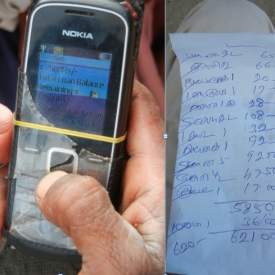
(Photo Credit: http://www.changemakers.com)
Kiva Zip: SMS Based Crowd Funding
Kiva is no stranger to Kenya’s burgeoning mobile technology scene either. One year ago, the non-profit launched Kiva Zip, an SMS based micro-lending pilot that connects lenders and borrowers through M-PESA. Since no banks or micro-finance institutions are involved, the loan is administered at 0% interest. Lenders from the world over are contributing to loans in Kenya , which are received and repaid entirely on mobile phones.
Ushahidi: Real Time Information Aggregate
Ushahidi, which means ‘testimony’ in Swahili, is a social media platform on which users can map out eye witness accounts of crisis, violence and protests in real time. Ushahidi is a non-profit tech company that develops free and open source software for information collection, visualization and interactive mapping. Users send reports of trouble through e-mail, text message or twitter that are inserted into an interactive map online.
In 2008, a group of Kenyan developers and bloggers created Ushahidi in response to the post-election violence sweeping their country. According to the Daily Nation, “Ushaidi maps crisis using a combination of Google mapping tools and crowd-sourced information.” Currently, the platform is used in 159 countries and has been translated into 39 languages. In 2010, for example, residents of Washing D.C. residents and New York utilized Ushahidi’s platform to report on and respond to the clean up effort surrounding major snow storms that hit both areas.
The Ushahidi staff launched an alternate website, Uchaguzi, specifically for the Kenyan election on Monday, March 4th. Kenyans are encouraged to text their reports and locations to Uchaguzi at ‘3002.’ In addition to documenting citizen reports, the site offers a comprehensive guide to governmental policies and procedures related to the election.

(Photo Credit: https://uchaguzi.co.ke/)
Kopo Kopo: M-PESA Merchant Accounts
Kopo Kopo allows small and medium business owners to set up separate merchant accounts to receive mobile payments from customers using M-PESA. The platform enables customers to send payments to vendors without the fee that is normally attached to a mobile money transfer. The added value includes increased security because of less dealings in cash, as well as unqiue opporunitiesto for business owners to interface with clients, like sending them SMS based advertisements. Kopo Kopo piloted their platform in Sierra Leone and Kenya. They’ve officially launched here in Kenya because of Safaricom’s M-PESA platform.
World Reader: E-readers for All
Former Amazon.com executive David Risher is the founder and CEO of World Reader, a non-profit whose mission is to make e-readers widely available in the developing world. World Reader’s most recent figures indicate that it has distributed more than 428,000 e-books to 3,000 children across Kenya, Uganda and Ghana. The organization has also launched Worldreader Mobile, an application that provides access to a large range of literature on mobile phones.
Open Data: Government Transparency
In addition to bringing high speed internet to Kenya, Communication Secretary Bitange Ndemo persuaded President Kibaki to add Kenya to the ranks of 25 countries participating in Open Data, a platform that makes non-classified government information available online for free. Although Kenya is officially on board, government officials haven’t quite warmed up to the idea of divulging their records. According to the Daily Nation “The Ministry of Information is currently developing a policy document to oblige government agencies to give up all non-classified information collected using tax-payer’s money.”
Mongolia Through the Senses
It’s been just over two weeks since I arrived in Ulaanbaatar, Mongolia’s capital, and there’s been much to take in. I’ve never been anywhere quite so foreign to me, where nothing about the culture, the food, the people, or the language is familiar. Chances are, these things aren’t familiar for many of this blog’s readers either. So for my first post from Mongolia, I’ve decided to take you through my new world through the senses, so you can get an idea of what it’s been like walking around in my shoes (or rather, my heavy winter boots).
The sights
I’ve been walking to work to my three microfinance partners in Ulaanbaatar (UB). Once in a while when I glance up, I’ll catch a glimpse of the beautiful mountains looming just beyond the borders of the city. UB, a sprawling city of 1.2 million, is nestled in the Khan Khentii mountain range. The mountains are covered in snow, although snowfalls are occasional and light throughout the country’s long and chilly winter. Despite the cold, one of the things I’ve loved so far here is how sunny it’s been: Mongolia averages 260 days of sun every year.
UB is a place where old meets new. For example, the Choijin Lama monastery (now museum), built at the turn of the last century, is just a stone’s throw away from the modern Blue Sky Tower. On a visit to the Gandan Monastery one day, one monk interrupted his prayers to answer a call on his cell phone. Throughout the city, old Soviet-style buildings are increasingly becoming flanked by new houses, condominiums, offices, and hotels. Some buildings can be deceiving, though: One apartment I saw had been built only a few short months ago, but resembled a dusty relic from the Cold War era.
In Mongolia, or at least its capital, status matters. Walking across Sukhbaatar Square in the centre of the city, I see multiple women sporting their Luis Vuitton bags. A glance to the east of the Square will reveal an Emporio Armani and a Burberry store. As I cross the street, I try to avoid colliding with a Hummer or a Lexus SUV.
But perhaps the most striking image for foreigners arriving in the city is the ger districts. Gers are felt-lined tents traditionally inhabited by Mongolian herders in the countryside, but today they are a common sight in the city as well. While gers may have a surprising amount of furniture and modern appliances inside, they also lack basic infrastructure such as running water and sanitation.
The smells
The coal stoves used to heat gers are one of the main contributing factors to UB’s notoriety as one of the world’s most polluted cities. The coal power plants that fuel the city are also a culprit. As I walk through the city, I’m reminded of the scent of campfire, and a whiff of it usually follows me indoors as well. The air is the heaviest in the mornings, although by midday it generally clears up.
The smokiness has also come from cigarettes, although that’s set to change now. Until March 1st, smoking was permitted in public places, including restaurants and bars. It’s something I wasn’t accustomed to, so it was a bit of an adjustment. Starting this month, however, a new smoking law took effect. Smoking is now banned in all public places, including outdoors, with private homes or specially designated ‘smoking centres’ being the only acceptable places to light up. It will be interesting to see how people respond to being made to stop their habit cold turkey—or whether the law will be enforced.
The tastes
Speaking of smells, the scent of cooking mutton is one that has quickly become familiar in restaurants and apartment buildings alike. There are an estimated 14 million sheep in Mongolia. It’s an impressive sheep-to-human ratio, given the country’s population of about 2.8 million.
Needless to say, mutton is a staple in the Mongolian diet, and a meal without meat is generally unthinkable here. At most restaurants, veggies are an afterthought—they often come in the form of a small carrot or cabbage salad. But produce is available in supermarkets, and thank goodness I’ve discovered Merkuri market. It not only features a separate section where veggies are piled high, it is also known for its wide variety of imported foreign foods.
As tasty as buuz and khuushuur have been, the culinary experience hasn’t been limited to local foods. In particular, Korean and Japanese restaurants are quite popular, and I’ve even sampled good Sri Lankan cuisine since I’ve been here.
The sounds
So, what does one hear when walking around UB? It turns out that Mongolian drivers are just as communicative as their counterparts in Costa Rica, if not more so. (I’m listening to a chorus of angry beeeeps as I write.) Apparently there’s a law against using car horns in residential areas, but good luck with that! Mongolia’s capital is very much alive; the traffic is heavy, and the drivers impatient.
Traffic is a little crazy in UB. Cars and pedestrians alike behave like water: They follow the path of least resistance. Lanes don’t matter; cars squeeze into whatever space they can fill. Double turning lanes form spontaneously as cars race to get ahead of each other. At intersections, the traffic is like a leaky faucet, continuing to flow long after the light has changed. In response, pedestrians cross where and when they can. I refused to at first, and found myself standing alone at the red light with a little girl. (OK, so I’m a wimp.)
The other striking sound to me is the Mongolian language. I’ve been picking up a few phrases here and there, but so far I’ve been largely immune to the conversations around me. And saying mit ku (I don’t know) to someone who tries to speak to me only adds to the confusion, since most people here mistake me for being a local. As for signs, the majority of them are written in Cyrillic, which I can’t yet decipher. Luckily, there are just enough people who speak English here to make life a little easier, and there’s no shortage of friendly and helpful people.

most signs are written in the Cyrillic alphabet, although occasionally the old Mongolian script is used
Mongolians tend to take an active interest in foreigners, which has helped me feel really welcome here. Many Mongolians speak a second or a third language, even if it’s not English (Russian is common). And the people that I’ve met so far have been wonderful. Ladies I barely know will take me by the arm and help me cross the street—and I’m pretty sure they’re not just using me as a shield against those massive Hummers.
That sweet numb feeling
So finally, how does one feel physically when arriving in UB in the middle of February? Not much, I can tell you, because I’ve gone numb from head to toe.
It’s not actually that bad. OK, so it was in the beginning. My first full day here, the temperature was -35oC and that wasn’t easy. Weather forecasts generally describe the days as ‘Cold. Frigid.’ which I think is a very fair description. But you get used to it, and with the right combination of thermal underwear and layering, you can conquer the cold.
UB has the dubious honour of being the coldest capital in the world, and average temperatures stay below freezing for a good six months of the year. But that’s funny, because I lived in Ottawa, Canada before starting my fellowships with Kiva and I could have sworn that IT was the coldest capital in the world. Some days are not that different here from what they are back home.
But timing has something to do with it as well. It seems I may have caught the tail end of winter this year. Tsagaan Sar, Mongolia’s Lunar New Year, was celebrated on February 11th and marks the beginning of spring. And although spring weather is known to be highly variable, it’s hard not to feel uplifted when the sun is shining and the temperature is soaring all the way up to -1oC. Sometimes cold weather can be immiserating, but my experiences in Mongolia so far couldn’t be further from that.
A Kiva Coordinator’s Community Orphan Care Center in Harare
Pamhidzayi (Pamhi) Mhongera leads all new and existing projects at the MicroKing microfinance institution in Harare, Zimbabwe. As part of her role, she oversees the Kiva program under which Zimbabwean entrepreneurs are given the opportunity to work their way up the socioeconomic ladder.
However Pamhi’s positive impact on her community extends beyond her daily work. She and her husband, Mustafa, launched their very own community orphan care outreach center, Blossoms Children Community in 2005. What started with caring for 26 orphans has grown to serve over 150 children as well as their respective caregivers.
Whereas Blossoms started with simply with providing orphan care and support, it quickly grew evident to Pamhi and Mustafa that there was a major need to help other kids living in adversity.
Most of the children’s’ stories are pretty typical; stemming from poor families, one or both parents absent from their lives, under the care of relatives who do not have the ability or willingness in ensuring their health and safety, etc.
Blossoms’ goal is to build relationships that enhance the well-being and development of orphans and other vulnerable children within their communities by:
- sending the kids to school and paying related school fees
- providing daily and/or weekly meals
- mentoring , counseling services and moral guidance
- talent development (music and dancing, sport)
- assistance to obtain proper medical services when needed
- referral services for vocational training and economic empowerment
In short, Pamhi and Mustafa act as mother and father for over 150 children by ensuring that they grow up in a healthy and safe environment.
Recently Pamhi has sought to push the number of children reached with the type of help and support that Blossoms offers.
In October 2012, she launched the UN International Day of the Girl Child, under the theme “Educate Girls – Change the World”, at Glen-View 1 High School, her former school in the suburbs of Harare.
Furthermore, through a partnership with the Brookings Institution, Pamhi has recently facilitated a counseling and trauma healing training program for 49 school teachers from 18 schools from the greater Harare region. The program aims to enable these teachers to provide psycho-social support to over 5,000 orphans and other vulnerable children through their respective school associations.
Pamhi and Mustafa face two main challenges in Blossoms’ operations:
1) They only have legal custody of the children until the age of 18. After that the kids have nowhere to go as well as a difficult time in finding any type of income given the socioeconomic situation in Zimbabwe.
2) Funding for all of the operations comes directly from Pamhi and Mustafa. They are presently trying to obtain funds from NGO sources but have run into all sorts of red tape.
Despite the challenges, Pamhi and Mustafa feel compelled as ever to help kids in need.
I had an opportunity of assisting the wedding of a former Blossoms’ boy who had “graduated” from the orphanage. At the ceremony, Pamhi, as any mother, was extremely proud but also tearful to see “her child” move on to adulthood.
But it is exactly this type of emotional investment that gives these kids the support they need to one day become independent and valuable members of the Zimbabwe community.
Africa’s Silicon Savannah: Why Kenya? Why now?
There is no shortage of articles documenting Africa’s position on the cusp of global development, with Kenya as a particular harbinger of those expectations. The Economist has reneged on writing off Africa as a “Hopeless Continent” several times since it featured the headline a decade ago. In 2011 it published “Africa Rising,” in which it identified 6 of the fastest growing countries in the world as African, with GDP growth surpassing East Asia. Last August, it dubbed Kenya Africa’s “Silicon Savannah,” bringing an onslaught of attention to the burgeoning technology scene here. Its March 2nd issue includes the article “Aspiring Africa,” that describes the continent as the fastest growing in the world.
The fan fare around African growth is not limited to sporadic shout outs from The Economist. Recently, Johnathon Kalan of the Huffington Post published an article that describes the fusion of “Potential, Poverty, Politics and Parties” that draws American college graduates to social enterprise start-ups in Nairobi. More important, however, is the current generation of young, educated Kenyans who are tired of the status quo. They feel entitled to jobs and livelihoods that are fulfilling and afford them some degree of social mobility. They are joined by Kenyans abroad, some of whom have been away for a decade at least, pursuing degrees and jobs, who are now choosing to return to Kenya for opportunities that did not exist when they emigrated. Together, these young professionals understand the role Kenya can play in spearheading growth for the entire continent. They are prepared to role back their sleeves and play a role.
As much chatter as there is surrounding Kenya’s burgeoning technology scene, most articles stop short of explaining why it’s happening in Kenya and why it’s happening now. This week, I’m digging a little deeper into the context behind the phenomenon.
Urban-Rural Dynamics
Until rapid urbanization began after independence, Kenya’s population was predominantly rural. In 1963, only 8% of the population lived in ‘towns’ or cities. Nairobi’s population was 267,000 and Mombasa’s was 180,000. Of those ‘townspeople,’ most were Arab, Indians and Europeans; not Africans, who typically worked in town for short or long periods, then returned to their rural homesteads where their families remained. Today, Nairobi’s population has grown to approximately 3 million people.
Although people are flocking to cities, their ties to the countryside are still strong. Often, one or a few family members migrate to cities and the rest of the family stays behind. A taxi driver I’ve used frequently is from the Naivasha area in Rift Valley. His wife and children remain in the country side, where he farms fruits and vegetables to sell at Nairobi bound markets. During the week, he leaves his family behind and comes to Nairobi to drive a taxi. This is a common arrangement in Kenya; city work during the week and village life on the weekends.
The movement from rural to urban by one or a few family members created the need for domestic remittance transfers. Family members are making money in the cities and need a way to send it back home. In other countries, like Mexico, where many family members work abroad, the opposite is true, the demand for external remittance flows are greater. Hence, Kenya’s unique rural-urban dichotomy set the stage for the internal funds transfer explosion that we’re amidst now. Once cheap mobile phones flooded the market, Safaricom filled the need with its SMS based money transfer platform, M-PESA, making Kenya the global leader in mobile banking technology. All of the subsequent innovations here have been inspired and made possible by the widespread use of cell phones and M-PESA.
Government and Infrastructure
The government is promoting the use of mobile money and technology development in Kenya. Bitenge Ndemo, who became minister of Information and Communication in 2005, is credited for spearheading the initiative. He bypassed ceaseless discussions between 23 African countries about launching a joint fiber optic cable, by linking right into a cable from the United Arab Emirates instead. It’s been his priority to lay down additional cables ever since. “When the cable was switched on in 2009, Ndemo made sure universities got unlimited internet capacity.” said Robin Dixon of the Los Angeles Times.
Bitenge Ndemo’s push for Kenya to become a regional technology hub does not end there. Most recently, he’s spearheaded the Konza Technology
City project, which broke ground on January 23rd. Fifteen kilometers outside of Nairobi, the $10 billion investment will be a public-private venture that includes a business district, science and technology parks, a university, conference facilities and residential areas. The government of Kenya anticipates that the project could yield 200,000 jobs in 20 years, along with sizeable investments in other sectors like health, education, manufacturing, financial services etc. Executives behind the project have already received 250 applications from local and international firms who would like to invest in Konza. Some of the multinational corporations seeking a piece of the pie include Samsung, Google and China’s Huawei Technologies.
Critics of the project have serious reservations about the government’s ability to bring such a large-scale project into fruition, when it has not yet managed to gain hold of municipal issues in the capital like traffic, electricity, water and drainage that fester under expansion. Nonetheless, the proposition and ground breaking of Konza represents a clear vision that policy makers and business executives have for Kenya as an ICT hub in the region.
Research Labs and Business Incubation
M: Lab East Africa at the University of Nairobi: Key to Kenya’s growing role in IT and mobile application development are its research labs and business incubation centers, where techies and entrepreneurs gather to collaborate, network and implement projects. In 2011, the University of Nairobi established M:Lab East Africa with the help of iHub, a local technology center. First funded by the World Bank InfoDev grant, the lab was founded to facilitate the innovation of low-cost, high value mobile applications.
iLab Africa at Strathmore University: Just on the other side of town, Strathmore University, Kenya’s premier private institution for business education, has its own research and incubation center called iLab Africa. At iLab, faculty and students have teamed up to develop mobile applications that overcome development challenges in health and education. ILab boasts a few high profile partnerships. For example, Strathmore and Safaricom offer a masters degree in mobile application development. Samsung has established an innovation lab there and Google funds IT education for girls in rural schools, in addition to sponsoring mobile application boot camps at Strathmore and elsewhere in the region.
With support from the Clinton Foundation and Ministry of Health, iLab has generated an application that tracks pre and post natal care of mothers and their babies in rural areas. They’ve also created one that sends the HIV status of newborns to doctors and clinics for treatment. On the education front, they’re mobile application development is centered around digital rights management and the provision of learning materials.
Climate Innovation Center (CIC) at Strathmore University: In addition to ilab Africa, Stathmore University hosts Kenya’s Climate Innovation Center, a climate technology innovation hub, established with the World Bank’s infoDev program. The center is poised to accelerate growth and innovation in renewable energy, agriculture and clean water by providing entrepreneurs with the funding, mentorship and facilities needed to innovate.
iHub: iHub is a physical nexus for the tech community in Nairobi. Established in 2010, it is an open facility for young entrepreneurs, programmers, designers and researchers. Free membership is offered to anyone with a demonstrated involvement in technology. Ihub provides access to facilities, networks for funding and opportunities to collaborate. You can become a member of its online community remotely, have physical access to the work space or pay a monthly fee for a semi-permanent desk.
Ihub’s very own research team is engaged in projects like their collaboration with Refugees United, an organization that helps refugees track missing family members. The team has upgraded the organization’s paper based sign up form to a WAP enabled sign up on mobile phones. They’ve generated easy to consume info-graphics about trends in East Africa and launched Spider M-Governance in 2011 to identify gaps in water governance transparency in Kenya.
A Former Kiva Fellow Launches His Own MFI in Zimbabwe
Meet Henry Bartram,
A career private equity professional in London who, about a decade ago, gave up his suit and tie to manage the British Red Cross response in Aceh, Indonesia after the December 2004 tsunami.
This experience led him to more social impact opportunities and ultimately to him becoming a Kiva Fellow. Henry was a member a KF15 and KF16, serving in Liberia and Zimbabwe respectively.
Combining his business acumen and his Kiva experience, Henry sought to start his very own microfinance institution. After several months dealing with all the paper work a new venture can expect to face, and after investing a good chunk of his life savings as well, Thrive Microfinance began training in March 2012 on the outskirts of Harare, Zimbabwe and started disbursing loans from September that year.
Thrive Microfinance’s goals is very simple: “To be the number one provider of developmental microfinance in Zimbabwe.” It aims to reach financial sustainability within 2 years of starting operations with all profits retained within the business for the benefit of borrowers.
Thrive focuses on issuing loans to groups of women who can learn from and support each other. But its true value proposition is not in simply handing out loans, Thrive invests enormously into each group by teaching the woman:
- the fundamentals of running a business,
- how to save for a rainy day and
- how to benefit from working in groups.
Thrive does not ask for collateral but focusses on creating strong relationships with its borrowers through a very high level of direct contact.
“Only 25% of the groups that apply for a loan actually make it through the 2-month training as there is a considerable drop-off when they come to open their group bank account. This is intentional as we want them to get a glimpse of the reality of the group guarantee.” says Henry. “We work tirelessly from the onset to make sure that nobody takes a loan until they possess the skills necessary to determine whether is in their own best interest to do so. We only lend when we are sure that the probability of benefit is much greater than the possibility of increased vulnerability.”
The training process takes about 8 weeks and includes the following steps:
1) Group assessment interview
Prior to starting the training, groups view an information video and attend a short interview in which Thrive assesses whether there is a real business, however small it may be, and whether the members of the group really know each other. Group members are also given two fact sheets explaining Thrive as well as its approach and the cost of borrowing.
2) Introduction to working in groups
Trainees are asked to their share expectations of their leaders and discuss the advantages of working in groups. They are shown how to take a regular health check on the strength of the group.
3) Group constitution and election of leaders
The group determines its rules & regulations – where they will meet, subscriptions, penalties etc and then go on to elect their own management committee. The group then goes on to open a group bank account.
4) Leadership training
The group leaders attend a session showing the Treasurer a suggested way of keeping the group’s financial records, a suggested agenda for group meetings and a series of tips from other chairs on how to get the group working well.
5) Financial training 1
Groups are shown how to keep simple daily records summarizing their business income and expenditure.
6) Financial training 2
Groups are taught the importance or regular savings, no matter how small and work through an illustration enabling them to identify examples of both good and bad borrowing. The costs of borrowing are carefully explained.
7) Financial training 3
This session focusses on developing a shared understanding of the key features, strengths and weaknesses of each business. Members of the group form mini-groups of 2 or 3 and share their work with the rest of the group. At this point, Thrive will visit each of the potential borrowers at their place of business.
8) Financial training 4
Group members bring their ‘shopping list’, a summary of what they want to spend the money on and how they expect to benefit. Members then calculate the cost of borrowing and the monthly repayment amount and determine whether it is their own best interest to go forward. They discuss how the group guarantee concept works.
Upon completion of the training program, Thrive considers the loan applications on the basis of probable benefit to the borrower. Thrive reviews both current debt bearing capacity and anticipated benefit from the loan. Post-disbursement, Thrive meets each group every month to review progress and deal with issues as they arise. To date, Thrive has experienced very high repayment rates.
Since September 2012, when the first loan was disbursed, Thrive has issued loans totalling over $125,000 USD to over 60 groups comprised of 350 borrowers. With 6 groups having graduated to their second loan cycle, Henry is confident that Thrive will have trained and lent to over 1,000 borrowers by the end of 2013. Thrive recently completed a Client Protection Principles Questionnaire and will implement the resultant recommendations by March 2013 and will have undergone a full Social Performance audit by the year end.
You can see the Thrive video at http://youtu.be/In7NuvK-fP0
Following a Kiva loan from Calgary to Dar es Salaam!
Marion Walls | KF19 | Tanzania
I’m on a quest to follow a Kiva loan from lender to borrower! How often have I dreamed of this whilst browsing my loans on a frosty winter weekend in Canada? Now I have an ideal opportunity to do so as the Kiva Fellow in Tanzania, so I’ll take you along for the ride!
My directions are set when a friend emails from Calgary: “I donated to the Jaguar Group. They’re asking for a loan in support of their beauty salon. I chose that one in honor of you – I figure you might want a haircut or a color given you are there for months!” Too true; I’ve been in Tanzania since September and this Kiva fellowship has been rich and rewarding, but also tough, so I’m looking a little ragged… And salons here offer beautifully intricate braids – why not give them a try?
I love the idea of making the personal connection between a Kiva lender in my hometown of Calgary, and a Kiva borrower here in Dar es Salaam! I had the dubious distinction in KF19 Fellows’ class of traveling furthest to my placement, so this will be an opportunity to reel in some of that distance. And what fun to report back to my friend on how his loan is working out here on the ground! I immediately start making arrangements to meet Juliet, the featured borrower of Jaguar Group…
Lender’s city; borrower’s city
You may already be familiar with Calgary – prosperous modern city buoyed by oil wealth; 5th largest metropolitan center in Canada; enviable location at the foot of the Rocky Mountains; renowned for its volunteer spirit; host city of the ’88 Winter Olympics (remember The Jamaican Bobsleigh Team?); 9th largest lender city on Kiva in 2011 (way to go Calgary)! In short: it’s a privileged city with a lot of heart!
What can I tell you about Dar es Salaam? The name conjures up exotic images of centuries old sea-trade, sultry summer evenings, and short ferry rides to magical Zanzibar island!
But the reality of daily life is far from tropical paradise for most of Dar’s 3 – 4 million inhabitants; believe me, this is one grindingly hard city in which to eke out a living… Still, people keep coming, lured by hopes of a better economic future than they face in their hometowns or villages. Dar is one of the fastest growing cities in the world. It’s a statistic with unenviable consequences: Dar’s infrastructure is clearly not keeping pace with the burgeoning population. Unrelenting heat and humidity are exacerbated by almost daily power cuts that mean no fans or air conditioning (in the words of my office-mate: “We are practicing for the fires of heaven!”), and no reliable refrigeration for foodstuff (where do maggots come from anyway?)
The dala-dala (bus) system is extensive and was genuinely well designed at inception – but now it’s inadequate and the overcrowding is epic! Likewise, unremitting traffic on overwhelmed roadways morphs the “5 p.m. rush hour” into the “2 – 8 p.m. standstill”. (Can traffic officers judge precisely when 64 passengers crammed in a sweltering dala with seating for 32 will finally reach breaking point? Only then do they signal us through the intersection!) Admittedly construction is underway to address transportation issues, but I regret the almost imperceptible progress in the 5 months I’ve been here.

Dala-dala: Never thought I’d be the one riding precariously on the bottom step, clinging tightly to the handrail because the door can’t close…
Yet, in the face of wretched infrastructure challenges and the fact that formal employment is not keeping pace with population pressures either, the people of Dar find ways to get by – they have to. So the informal economy is bustling and every hot and dusty road is lined with shops and stalls; every opportune space is claimed. (Note to self: “That’s why Kiva loans to entrepreneurs are so relevant in Dar!”)
And if half of all Tanzanians are getting by on $2 per day per Kiva’s country statistics, it’s surely not from want of trying: it’s common to work long hours here in Dar.
No two ways about it – it’s a hardscrabble life here. But there’s a side to this city that defies all expectations: people in Dar (as in all Tanzania, in fact) are extraordinarily friendly, and helpful, and tolerant! I know it sounds cliched, but this is truly friendliness, and willingness to help, and tolerance, on a scale I’ve seldom encountered in my travels on any continent. It occurs to me this is the real key to living in Dar!
The expedition across town
Of course you realize Kiva borrowers don’t work in downtown office towers, but still you might be surprised by the widespread locations of their businesses (such as Juliet’s salon). Greater Dar es Salaam area is extensive, and many Kiva borrowers live and work on the outer fringes – perhaps 50 km away from my base at the main branch of Kiva’s partner MFI, Tujijenge Tanzania.
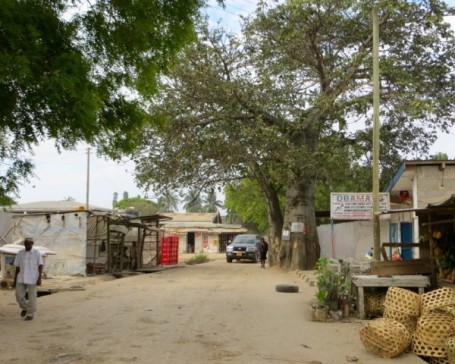
The road I walk to the office, just outside the downtown core. Main roads are paved; most others not.
I had no concept of the stamina it would require before I started visiting borrowers last September! My mind boggles when I consider that loan officers from Tujijenge routinely travel across Dar to attend borrower group meetings every week… (The numerous challenges MFIs such as Tujijenge face in delivering services here in Dar are daunting. That’s why I admire MFIs for working here – where the need for microfinance is great, where it can make a significant impact on the lives of borrowers, but where it is not easy.) The loan officers are all busy as bees so I enlist Rita, the star Kiva Coordinator at Tujijenge, to join me on this visit to Juliet. We set off together, as always.

Rita: Kiva Coordinator, and my invaluable helpmate and friend for the last 4 months. I couldn’t have made it in Dar without her!
I use my favorite strategy: Start early in the morning. Take a series of “city-bus” dalas to the furthest point at which bajajis (auto rickshaws, named for the pricipal company that makes them) are available. Cover the final stretch to the borrower by bajaji, because the alternative of switching first to a “mini-bus” dala then risking life and limb on a piki-piki (motorbike taxi) is no fun at all. Persuade the bajaji driver to wait whilst we visit the borrower. Then do the trip in reverse. And hope to get home before dark…
(Rita scolds me for excessive expenditure on bajajis, but I can’t help it: I love everything about them! Bajaji drivers are fearless; they are consummate alternate-route-finders in the face of traffic jams; they are willing to tackle any road. Bajajis can negotiate all terrains successfully, or at least are light enough for this Kiva Fellow to push out of the sand when stuck… The open-air design provides sweet relief from the heat (even if the air I’m breathing is laden with diesel fumes, and bugs impale themselves on my camera lens), and I can choose how many of us are on board. I bet you’d take a bajaji too, if you had the chance!)
On today’s trip to see Juliet, a second bajaji driver dashes up just as we finish negotiating our fare with the first. “Mama,” he calls to Rita, “you gave me my loan at Tujijenge!” It means he has a Kiva loan! “Oh, I wish we could go with you then,” Rita responds. “It’s alright, you can go with him – he’s my friend,” says the Kiva guy, with characteristic Tanzanian friendliness. (What a great coincidence! I told you I love bajajis!)
Meeting the borrower
Turns out my meeting with Juliet is not happening after all… Instead of Juliet, Prisca is waiting for me at the roadside. Prisca is Chairman of Jaguar Group, and she tells me Juliet has bowed out today. Of course I’m disappointed, but I try to imagine myself in Juliet’s position as a borrower. Is she simply too shy? Battling a family or business crisis she’d rather not discuss? Scared because she’s behind on a repayment (even though she’s paid off 5 previous Tujijenge loans successfully)? Unwilling to have nosy neighbors learn from my obvious presence that she has a loan (out of financial privacy concerns, or because they may press for a share of the cash)? Unwilling to have her husband learn she has a loan (and thus jeopardize her personal financial stability)? Or is it something else entirely? I don’t know, but I’d far rather Juliet refuses than indulges me at her own expense – my visit is purely whimsical and not business related. It’s an apt reminder that a borrower’s loan is a significant business contract that is not undertaken lightly; it must be managed and paid back in the context of real-life complexities.
Meeting the borrower (Take 2)
Prisca saves the day by inviting me back to her store. I’m very happy to accept because, after all, the Kiva loan covers Jaguar Group, not Juliet alone. (Group loans are a mainstay of microfinance. You can read about their many benefits in Dar in my earlier Kiva post: Group Loans – Filling a Particular Niche.) Prisca hops aboard our bajaji and we’re off on a roller-coaster ride!
Prisca owns an impressively well-maintained store selling sodas (pop) and beer. There’s a shady seating area too, so Rita, the Bajaji driver, Prisca, and I settle down to enjoy a cold soda (bonus – Prisca has a fridge!) and a chat. I show Prisca her Jaguar Group’s loan on Kiva, and she breaks into a wide smile as she sees herself in the photo! She quickly points out Juliet, as well as Judith who was featured in Jaguar’s previous Kiva loan. She’s somewhat incredulous when I point out my friend from Calgary in the Lender section…
I ask Prisca about herself. She’s married, has a young son and daughter, and has always lived in this area of Dar. Her store used to stock a wide variety of goods but in 2011 thieves broke in and stole pretty much everything, including the scale for weighing goods like rice and dried beans. It was a cruel setback. That’s when Prisca joined Jaguar Group and started taking loans from Tujijenge to try to get back on her feet. Yes, the series of loans have helped restore her business – injections of cash every few months are invaluable in buying bulk stock at cheaper prices, and purchasing items like the fridge to draw customers. Some of the extra profit that is generated helps with household expenses (think school fees) too. But there’s still a way to go… That’s why Prisca has stayed with Jaguar Group, and recently become group Chairman.
Closing the circle
I’ve done what I’ve always dreamed of doing: followed a Kiva loan from lender to borrower! Now I know the people on both sides of the contract, and I’m totally delighted.
I report back to Calgary: “The bajaji ride was one of the best yet! The rest of things didn’t quite go to plan, but still they ended well. I met Prisca, not Juliet. I got a soda, not braids… Prisca was amazed to see you! Her business is coming along, and she says the loan is helping. Here’s the postcard I made you – it was a brilliant day, thank you! M.”
Click here to lend to a Kiva borrower in Dar es Salaam. (Please check back at the start of next month if all Tujijenge Tanzanian loans are currently funded!)
See more of the daily sights I’ve enjoyed in and around Dar in The Illustrated Guide to Cooking Thanksgiving Dinner! (Tanzania Edition). Or see the complete antithesis in On the Road Less Travelled: Kagera Region in Tanzania.
The Filipino Sense of Community
Keith Baillie | KF19 | Philippines
Part I: Construction of a New Community
Following the Sendong typhoon, many Cagayan de Oro residents were displaced. I visited one of the resettlement villages, Xavier Ecoville. Flood victims are still currently living in temporary wooden accommodation built by agencies like Habitat for Humanity.
Temporary housing:

But new permanent housing is being constructed, with the philosophy “We are not just building houses, we are building a community”.

Among the first facilities constructed are a church and a community hall. There are also a health and family planning center, day care and preschool facilities, and covered basketball and volleyball court. Housing is in low-rise terraces, enabling neighbors to mingle in the street.
Part II: Factors Driving Community Spirit
If I mention that I am visiting or eating somewhere, they always ask “Who’s with you, sir?” I ask myself “What are the factors that drive the strong Filipino sense of community?” Here are some factors that occur to me:
- Strong family bonds. Filipinos typically have large families. Working children are responsible for helping support parents and younger siblings (including their education). Children will frequently work abroad to accomplish this. Such family obligations imprint a model for shared responsibility in the broader community.
Note: However, nowadays many Filipino couples separate and many children are born outside of marriage. Nevertheless, parents or grandparents always take care of the children if the mother cannot. - Living accommodation. Single Filipinos typically live with their family until they marry and establish their own family home. Young Filipinos studying or working away from home typically live with colleagues in boarding houses, which provides a community atmosphere in place of the family home. Few Filipinos live completely alone, even when elderly.
- Shared religion. (I have worked in Christian areas but suspect the same holds true in Muslim and indigenous areas.) Almost all Filipinos I have met have a strong, active Christian faith. Although most are Catholic, other denominations are integrated in non-sectarian events, like religious festivals/fiestas and office devotionals. One of the first questions Filipinos ask me is “What is your religion?”
- Avoidance of conflict. Filipinos rarely get angry or raise their voices. If I say something critical, a Filipino will ask “Are you mad at me, Sir?” leading me to soften my response. I do not see angry rows or fights even in drinking establishments. When I berated a young girl for pushing in front of me in a grocery line, she just remained silent. And when my motorcycle taxi nearly collided with a motorcyclist who had pulled in front of him, there were no expletives. They both just smiled and chuckled.
- Community service. I met a large group of students who were studying a college course in cleaning neighborhoods and planting mangroves. When they graduate, they will be unpaid volunteers. In the cooperatives I have visited, serving the community (especially the poor) is always stressed in the devotionals and board members provide their time for free.
- Performances and shows. Church, school, college and office events bring people together to practice for dance performances, beauty contests, sports contests, etc.
- Fiestas. Each municipality has an annual fiesta when community members who live away return home. There are family reunions, school reunions, church services, public entertainments, and the roaming meals where people visit a succession of homes to eat.
- Texting. Throughout the day, Filipinos text small talk like “Good morning!” and “Have you had your breakfast?” This is an extension of normal social interaction.
- Maintenance of local bonds while away. Overseas Filipino Workers (OFWs) maintain social connections with others from their city or region – for example maids in Hong Kong or workers in the Middle East congregate on particular streets or intersections designated for their home location.
Whatever the reasons, there is no doubt that Filipinos have a strong sense of community – both with other Filipinos and (happily) in welcoming visitors from other cultures.
Afterthought: This may explain why Filipinos so readily ask foreigners for money. When they see financial inequality, it seems only right to share it. However, they don’t seem to resent the rich-poor divide within their own country enough to change it.
My first everything in Ghana
After an easy trip. I arrive to Accra, Ghana. The first feeling you have when you step out of the plane is an intense hot an humidity, and this in when you miss the snow at home.
It is 8 PM and the Ghanian national football team is playing the semifinals of the African Cup against Burkina Faso. The whole country is mobilized. I can hear the screams all along the airport. For the moment they are drawing, but with good opportunites. Maybe it is because of the macth that taxi drivers are behaving in a foolish way. I asked one of them about a hostel I knew, and he answers me he takes me there without any problem. I jumped on the taxi with all my stuff, we move forward few meters and he starts asking everyone where the hostel is. I ask him if he truly knows where it is, and he answers me no.
I make the same process with another taxi and it happens completely the same, till a kind woman called Evelyn, offers me her help. She told me she knew a hostel not far from her home. I relied on her and her little son John.
After a few minutes drive we arrive to the hostel. It was not as cheap as I expected, but it is 10 am, I am exhausted and the last thing I want to do is wandering in an African city of 3,5 million habitants. I go straight to bed.
The day after everything is the first time for me.
My first bedroom

Mi first sight of Accra
My first bathroom

My first coconut

My first meal
My first defeat.
I realize Ghana lost in penalties. It is in that moment when I remind they almost are the first African country in reaching Worldcup semifinals. An Uruguayan player´s hand and the latter missed penalty of a Ghanian player impeded it.
Bad luck in football continues for me. In El Salvador I attended with Fundación Campo Microfinance the qualifying game between Costa Rica and El Salvador. Of course, they lost.
But this event do not remove the smiles from them. They know what is suffering in the field and out of it. This is why they give thanks for reaching so far and they will try again harder than ever next year.

The day after the defeat, some supporter demonstraiting their devotion for the national team.
A Day in the Life of a Loan Officer: Comparing Honduras, Colombia and the United States
By Rose Larsen, KF19 Colombia, with excerpts provided by Wesley Schrock, KF19 Honduras, and Luan Nio, KF18 Nicaragua/KF19 United States
Loan officers are the hidden heroes behind the Kiva model.
Lenders, borrowers, Kiva staff and Kiva fellows all show their beautiful faces somewhere on Kiva.org, and while Kiva’s field partners have profiles of their own, there is little explanation or clarity behind who actually, physically, goes to the clients’ businesses, evaluates their requests, delivers loans and picks up repayments (hint: it’s loan officers!). Likewise, loan officers have varying degrees of knowledge about (or interest in) what Kiva is – some are enthusiastic supporters, while others are just doing their job, the photos and borrower profile information just one extra step as they navigate the hundreds of borrowers that they work with.
Yet in my experience, no matter what their attitude is towards Kiva, these loan officers care deeply about their clients, are well known in their sector or neighborhood, and work long hours to ensure that anyone who wants a loan has the chance to apply for one.
I got to know quite a few while here in Colombia, as I accompanied a different loan officer on each trip to the field. Loan officers are often a Kiva Fellow’s best friend in the field, so I asked a few other fellows what their experiences with loan officers was like.
Unsurprisingly, just as all of our field partners vary immensely, the jobs and lives of the loan officers vary across different regions. To give you a better idea of what a somewhat hidden yet key part of the Kiva process looks like, we’ll travel around the world visiting three different microfinance institutions and getting to know three different loan officers, learning about why they do the work that they do, and seeing a little bit of their daily routine.
Loan Officer #1: Jarling, Loan Officer with COMIXMUL, Honduras
Kiva Fellow: Wesley Schrock, KF19 Honduras
MFI Background: COMIXMUL is a savings and loan cooperative exclusively for women in Honduras. They are a new Kiva field partner and have yet to post a loan to the site (although they might have a few up by the time this blog is posted). COMIXMUL hopes to fund three specific products on Kiva: agriculture loans, youth entrepreneurship loans and solar panel loans – all products for which traditional funding is limited.
Personal Background: Jarling, who has worked as COMIXMUL loan officer for 3 years, is 30 years old, married, and has 2 children. Previously, he worked as a sales representative for a drinking water company. This sales and customer service experience made him an ideal candidate for COMIXMUL’s loan officer training program. After successfully completing 2 months of training, Jarling was a full-fledged loan officer, responsible for building and maintaining his own loan portfolio. Unlike his previous employer, COMIXMUL offers a competitive salary, a benefits package, and the opportunity for career advancement.
In the Office: Loan officers work Monday through Friday from 8AM – 5PM and Saturday from 8AM – 12PM. The day begins and ends in the office, which Jarling walks to and from. Administrative duties, like making sure a client’s loan application materials are in order, require an hour or two at the start and end of each day. Jarling works out of a shared office, but has his own small desk with a desktop computer. While clients do not use email, all clients have mobile phones. Hence, all client communication is done in person or over the phone.
In the Field: The majority of the day is spent riding around on a COMIXMUL-owned motorcycle visiting existing clients or promoting the cooperative in an effort to gain new members. Jarling might visit an existing client simply as a courtesy, but more likely because the client is delinquent, or wants to refinance an existing loan, or is seeking a new loan. He manages a portfolio of 110 clients whose businesses include convenience stores, food stands or restaurants, new and used clothing stores, bakeries, and pastry shops. The day’s schedule permitting, lunch is taken at home; however, he often has to lunch in restaurants or food stands.
*In the video, Jarling is meeting with a client, Maria, who runs two clothing stores. COMIXMUL has helped her to expand her business; when she started with the cooperative 3 years ago, she had only 1 store. Jarling paid Maria a visit because she was over a week late in making her December loan payment. Given Maria’s excellent repayment history, the tone of the visit was friendly; Jarling just wanted to find out the reason for the delinquency. Maria explained that she had extra holiday expenses, but promised to make the repayment the following week. Taking her for her word, Jarling amicably departed.
Implementing Kiva: Jarling has moved up the ladder at COMIXMUL: as a veteran loan officer he now serves an exclusively urban clientele. His initial territory was a rural area, in which agricultural loans predominate. From a loan officer perspective, an urban clientele is more desirable because urban areas are easier to serve – distances are shorter, mobile phone reception is better, and the routes are safer. Given his territory, Jarling will only be working with one Kiva product, youth entrepreneurship loans. COMIXMUL’s established processes mimic the Kiva model: loan officers are accustomed to taking client photos, writing client biographies, and tracking client progress. Hence, he doesn’t anticipate that implementing Kiva will pose significant challenges.
Loan Officer #2: Mario, Loan Officer with Fundación Mario Santo Domingo, Colombia
Kiva Fellow: Rose Larsen, KF19 Colombia
MFI Background: Fundación Mario Santo Domingo (FMSD) has been with Kiva for over three years, and has been working in the microfinance sector for more than 30 years. They work primarily with borrowers on the Caribbean coast, in the cities of Barranquilla and Cartagena. Most of their loans are for traditional urban businesses like beauty salons, corner stores and fruit stands. They also have many other social projects, including trainings for entrepreneurs, affordable housing projects, and even an ecological high school for poor children on Isla Baru.
Personal Background: Mario has been a loan officer for FMSD for almost 21 years. He studied accounting and financial administration at a local university, and says that he never imagined working as a loan officer. However, one of his professors was also a director at FMSD and encouraged him to take the exam to become a loan officer. Mario lives in a northern neighborhood in Barranquilla with his wife and two children, and has been assigned a variety of neighborhoods in the southern sectors to work in. FMSD helped him buy a car through loans, so now he is easily able to cover the wide swath of city he has been assigned. Though it is challenging to deal with so many clients, and to often have to sort through difficult situations, Mario loves that his job allows him to work with people, and seeing people improve their lives through microloans makes it all worth it to him.
In the Office: Mario generally spends mornings in the office, working from 8 to 12:30 processing paperwork, organizing clients’ loan applications, and calling clients. His phone is constantly ringing with calls from both current and potential clients. He also attends weekly credit committee meetings with other loan officers and his boss, to discuss new clients and determine whether or not they will receive loans.
In the Field: Mario’s afternoons are spent in the field, visiting clients all over Barranquilla. After stopping home for lunch, he heads out in his car to visit new clients, check in on current clients and follow up with clients who have finished their loans. Mario currently manages 260 clients, visiting 4 or 5 per day when he needs new information from them, or up to 9 when he’s just checking in to see how they are doing. Another important part of an FMSD loan officer’s job is promotions, or attracting new clients – Mario is constantly looking around for new businesses near his current clients to offer loans to.
On the day I spent with Mario, we spent time with 3 clients and stopped in to say hello to 2 more. One visit was with a seamstress who was asking for a non-Kiva loan (any loan over $1500 is provided with FMSD’s other funding source, although it has a higher interest rate), another visit was with a new Kiva client, a woman selling lotions and perfumes out of her home, and the final visit was to check in on a client who wanted a new loan but couldn’t find a co-signer to back the loan.
Implementing Kiva: Mario is a great believer in Kiva, even though taking photos of clients and filling out Kiva forms adds some extra time to his work. Though there are many other banks and NGOs providing loans in Barranquilla, Mario says that working with Kiva distinguishes FMSD from the rest.
Making a difference: There is no doubt that the loan officer job is very difficult. Mario struggles to maintain positive relationships even with clients who are constantly late with repayments. But he knows that he is making a difference not only in the lives of individual clients, but in Colombia as a whole. When FMSD first started giving out loans in 1984, it was the only player in the field. Now, many commercial banks and other organizations are giving out loans too, and Colombia is becoming more developed. He notes that by offering his clients, many of whom are very poor, access to financial services, he is giving them more confidence in themselves. They see that someone trusts them to take out a loan and this encourages them to follow their dreams and work hard to improve their lives.
But don’t take my word for it, check out what Mario has to say about whether a loan officer’s job is fulfilling or not:
Loan Officer #3: Nick, Loan Officer with ACCION San Diego, USA
Kiva Fellow: Luan Nio, KF19 United States
MFI Background: ACCION San Diego is one branch of a microfinance institution that operates all across the US as well as internationally. They are new to Kiva, with just four months on Kiva’s site and 23 loans so far. They help small business owners and entrepreneurs in the San Diego area get funding, which can be complicated for new businesses in the US, and also offer business training and workshops on important subjects like marketing, finance, and legal issues.
Differences between US partners and international partners: Luan is unique in that she worked with a partner in Nicaragua as a member of KF18, and now is serving in the US in KF19. She offers some perspective on the differences in loan officers’ roles in the US versus a less developed country:
Based on my experience between Nicaragua and the US, the main differences I can see are as follows:
- More use of technology here, especially when communicating with clients. Loan officers here are more often in the office than in the field because they use e-mail and phone more, and they have fast cars and highways so site visits don’t require much time. Everyone here has internet and some people (including loan officer Nick) have 2 computer screens.
- Both clients and loan officers here fully grasp the idea of Kiva and are able to exploit it to the fullest. ACCION SD, for example, aims to do mostly videos for both new borrower profiles as well as for journals. Kiva clients here may use their Kiva profile for marketing, though we haven’t seen this yet since ACCION SD is just getting started with Kiva.
- Here, Kiva lenders and Kiva borrowers often live in the same country, so the borrower-lender connection might be stronger. You can actually visit the business you lent to in person here. It is therefore easier for loan officers to “sell” Kiva to clients.
Conclusion
As the three profiles show, while the main functions of loan officers’ jobs around the world are the same, their lives can vary immensely.
Their jobs are divided between time in the office and time in the field, but the amount of time spent in each depends on a variety of conditions:
- Where their borrowers are located – loan officers with borrowers who are more spread out or in rural areas with bad roads spend more time in the field. All three loan officers profiled spend less time in the field than some of their counterparts, because they work mainly in urban areas.
- Levels of technological development in the country – in Honduras and Colombia, mobile phones are widespread, cutting down on some visits as loan officers can call most of their clients for quick questions, and are also able to schedule appointments in advance. In less developed areas with little access to phones, loan officers must visit clients every time they have a question, and may arrive at the client’s house when the client isn’t home. In the US, even fewer visits are required as many items of business can be taken care of via phone and email, which most borrowers have access to. Also, roads are better so trips to the field don’t take as long.
- Microfinance Institution (MFI) policies – Because FMSD clients repay their loans by going to a bank and transferring the money to FMSD, loan officers don’t have to visit clients for repayments. ACCION San Diego clients also mail checks into the MFI. This means much less time in the field than organizations that require loan officers to pick up repayments (even when it’s just a few dollars a week).
Still, in the end, these loan officers in North, Central and South America do have a lot in common – they are all dedicated to their clients, which means that even if following Kiva’s extra rules and procedures (filling out extra paperwork and taking photos of their clients) adds some time to their day, they are each happy to put in the extra work so that clients who normally wouldn’t get a loan finally have access to credit. There are hundreds or perhaps thousands of loan officers around the world who work with Kiva clients, and from what I’ve heard from other fellows, it’s safe to say that Jarling, Mario and Nick are not atypical in their commitment to their clients.
So the next time you read a detailed borrower profile, spot an especially well-framed photo or receive an interesting journal update, think about all the work put in behind the scenes by a hardworking loan officer!
Special thanks to Jarling Ramírez, Mario Moreno and Nick Miluso for agreeing to let a Kiva Fellow follow them around all day, even though they are all incredibly busy!
Support these loan officers and the organizations they work for by making a loan to a borrower from COMIXMUL, FMSD or ACCION San Diego. Want to meet some loan officers in person? Read more about the Kiva Fellows Program, and then apply to be a Fellow!
Kiva One: Faces that Impacted the Lives of Kiva Fellows
By Kiva Fellows | KF19 | All Over the World
With January 2013 coming to an end, KF19 fellows are either continuing on with KF20 or returning home to various responsibilities and careers. Regardless of the next adventure or destination, one thing is common among all: KF19 fellows have been permanently changed by their placements.
What began as a joint blog post about any person, place, or event during the course of the fellowship that affected our lives, of itself turned into simply the one person who left the most impact. Afterall, Kiva’s mission is to alleviate poverty through connecting people. The fellows of KF19 have witnessed this connection over the course of the last three to four months, and nothing could have prepared us for meeting the people who would touch our lives in various ways.
KF19 presents to you Kiva One, a small collection of stories about human connections, hope, and inspiration.
Kick Trading Photo blog
Why should you fund a Kick Trading loan?
Kick trading, Kisumu Innovation Centre Kenya, was one of our favourite groups because the borrowers were enthusiastic and their workspace was bright. We entered to see some artisans painting, others selling items in the colourful stalls, as we ducked under hundreds of mini wire bicycles and Santa Clauses in the outdoor workspace.
Kick trading provides training opportunities to young artisans and allows them to earn a fair wage. They are encouraged to be creative by hand making products using hyacinth and papyrus from Lake Victoria.
Log on to Kiva Zip today https://zip.kiva.org/
Kiva Zip and Job Creation: Profile of a Kiva Zip Trustee
By Rachel Davis | KF19 | Denver, Colorado
For the past four months, I have been serving as a Kiva Zip Fellow in Denver, Colorado. As a fellow in the US I was required to work independently without the comfort of a home office or co-workers. The Zip fellowship is in and of itself, very entrepreneurial. First came research, then networking, then meetings, then events, then more networking. I’ve met so many fascinating people and have come to know so many amazing organizations doing crucial work in my own backyard.
The work of one organization in particular has really resonated with me, that of Mi Casa Resource Center. Mi Casa was founded in 1976 and has been providing support to ensure the economic success of Latino families in the Denver Metro area. Mi Casa provides after school programs, business classes, as well as other resources. The program that Kiva Zip has been working with is an entrepreneurial training program taught in both English and Spanish. Students are required to graduate from the program, they then become eligible for a Zip loan.
We have lent to three borrowers endorsed by Mi Casa, all of which are starting their own businesses. One is starting a catering and food cart business, one is opening her own hair studio, and one has launched his own construction company. These borrowers are self-employed entrepreneurs with skills that provide new opportunity for minorities. With the help of Mi Casa and Kiva Zip they have created readily available jobs to people in their communities. Instead of a top down approach to job creation, these borrowers are creating jobs from the bottom up. Jobs with dignity that require specialized skills, jobs that they can be proud of.
A few months ago I had the pleasure of attending one of the classes at Mi Casa. The classes are held in the evening and every week one of the students provides refreshments for everyone. I can’t describe how humbling it was to sit in that room. Every student was attentive and asking questions, participating, eagerly scribbling notes as if the information was about to just slip away and be lost forever. It was quite the departure from what I experienced at my traditional four-year public university. For these people, it was real – at the end of the program they will launch their businesses and it’s sink or swim.
Job creation is such a hot button issue these days and there is no universal solution. But seeing the Zip borrowers in person, seeing their drive and their passion to aim higher is encouraging if nothing else. With the right resources and bit of direction, creating a job for yourself and those around you is within reach. I can say confidently that Kiva Zip is giving entrepreneurs in the United States a chance to follow their dreams and it’s giving people an opportunity to find dignity and acceptance among our lenders. I’m passionate about this work and I am excited to see what the future holds for Kiva Zip and Mi Casa Resource Center.
You can visit Mi Casa’s trustee page at: https://zip.kiva.org/trustees/136
The Happiest Country on Earth
Rose Larsen | KF19 | Colombia
After traveling for almost a month over Christmas holidays, I was struggling to figure out why I was so happy to be back “home” in Barranquilla, the hot, humid, chaotic city on the Caribbean coast of Colombia that I’ve been living in for the past 4 months. I had just visited places of incredible beauty like:
Montezuma, Costa Rica
Isla Ometepe, Nicaragua
and Medellin, Colombia.
But as much fun as I had, none of these places measured up.
Then I read the news and everything made sense.
According to the Global Barometer of Hope and Happiness, Colombia is the happiest country on earth and Barranquilla is the happiest region in this happiest of countries.
Though a study of just 54 countries defining an entire population by one overly simplified emotion should perhaps be taken with a grain of salt, this is good news for a country that is still overwhelmingly known for kidnappings, guerillas and Pablo Escobar. The most common reaction when I tell people I’m living in Colombia is, “Isn’t it dangerous?!” – and this from people who have traveled through Honduras and El Salvador, countries #1 and #2 on the list of homicide rates by firearm.
But while stereotypes about Colombia are exaggerated, the country is far from perfect, and its notorious history will never be completely erased.
So that leaves me wondering, why is a country with 37% living below the poverty line, between 3.9 and 5.5 million internally displaced people, and the world’s leading coca cultivator (source) so happy?
Most Colombians remember when they couldn’t leave their town or city because so much of the country was controlled by guerillas or paramilitary forces. There are still parts of the country out of government control. And I’ve seen for myself that many live in makeshift homes, slums and even on the streets.
Still, right from the start, I noticed how cheerful and happy Colombians tend to be. Life here, particularly on the coast, is colorful and warm. Happy, upbeat music like the local vallenato or more regionally popular salsa blares from parked cars, shops and homes; traffic is a mess but there is very little road rage; and the people dress mainly in bright colors.
Colombians are huge partiers – every weekend of the year you can find at least one city or region celebrating some kind of festival. Particularly famous is the Feria de las Flores in Medellin, the annual national beauty contest in Cartagena and of course, Barranquilla’s Carnaval!
Most significant has been how warmly I’ve been welcomed into this culture. I never worry about getting lost or not knowing when to get off the bus – the moment I ask for help people scramble over each other to give me advice and make sure I get where I’m going. Neighbors, colleagues and new friends have been so welcoming, and the Kiva borrowers I’ve met have been smiling and friendly, happily posing for the pictures and videos I’ve taken and sharing stories about their lives and businesses.
I have no answers as to why Colombia is so happy, but I have some hypotheses.
One is that Colombians have been through A LOT in the past 50 years, dealing with the FARC, drug cartels, paramilitary forces and the seemingly uncountable murders and kidnappings that accompanied them. Colombians had to stay positive to get through such tough years, and now as violence is decreasing, the economy is growing and tourism is booming, there is a lot to be happy about. Unlike Americans, Europeans, and residents of many other parts of the world currently experiencing economic downturns, Colombia’s future looks bright!
Another possible reason for such high levels of happiness is the strong culture of family that is prevalent across all of Latin America. That could also explain why Latin America has the highest level of happiness of all regions of the world, almost twice as high as the runner up. Colombians are very family centric, celebrating holidays with huge family gatherings and depending on their families to help them out in rough times.
Then, of course, there is the natural beauty that surrounds Colombians at all times. Colombia is home to mountain ranges, Amazon rainforest, tropical Caribbean beaches, and fertile valleys. The cities are vibrant and varied, with an increasing level of culture as Colombia’s economy and international investment grows. From the farms of the coffee region to the clubs of hip Medellin to the beaches of Parque Tayrona, Colombia is filled with breathtaking spots.
Or maybe it’s more simple than all of that – Colombia’s soccer team was in fifth place in the World Cup rankings for 2012!
Whatever the reason may be, living in Colombia has taught me to relax, see the bright side of things, and be more friendly and open. I think all of us in less happy nations such as the United States (#31 out of 54), Italy (#45) or the United Kingdom (#38) have a lot to learn from Colombians.
A Day in the Life of a Kiva Fellow [VIDEO]
Here is a peek into my daily routine as a Kiva Fellow in Sololá, Guatemala. My schedule usually goes something like this…
8:00AM – Wake-Up
8:15AM – Emails, Updates and Writing for my travel blog
8:45AM – Arrive at ADICLA Office in Sololá, Guatemala
9:00AM – Plan our day of borrower visits, Kiva training and other tasks
10:00AM – Leave office
10:20AM – Morning snack at the central market in Sololá
10:40AM – Begin motorcycle ride into the countryside to visit borrowers
11:30AM – Arrive at first borrower’s home to gather information, take photos and get a participation signature (in this video we filmed a Kiva”Thank You” piece)
12:15PM – Arrive at second borrower’s home (in this video the borrower didn’t arrive, which is a regular occurrence when there are crops to be harvested)
1:30PM – Lunch at one of my favorite spots just outside the town of San Andres. Churrasco, chorizo, black beans, tomato sauce, cheese and a Coca Cola!
2:30PM – Wait at the San Andres ADICLA Office for a borrower group to arrive. Juan Carlos and I exchanged language lessons (Kakchiquel and English).
3:00PM – Group Borrower Meeting
3:45PM – Ride back to Sololá
5:10PM – Upload new borrower profiles
7:00PM – Leave office for the night, change and snack
7:30PM – Get it right. Get it tight.
8:15PM – Grocery shopping
8:45PM – Shower and Dinner
9:30PM – Catch up on emails, writing, Kiva Fellow tasks and travel blog work
That’s my day as a Kiva Fellow!
